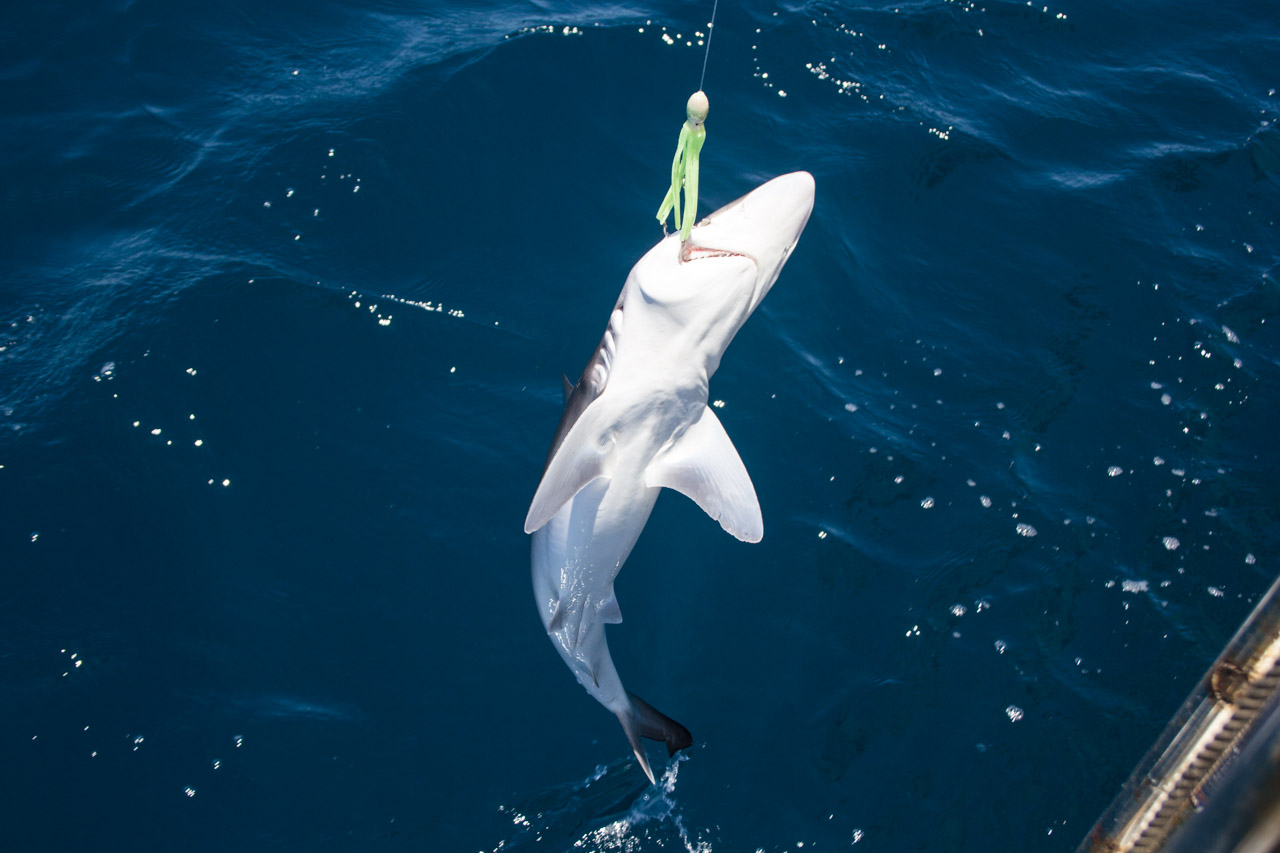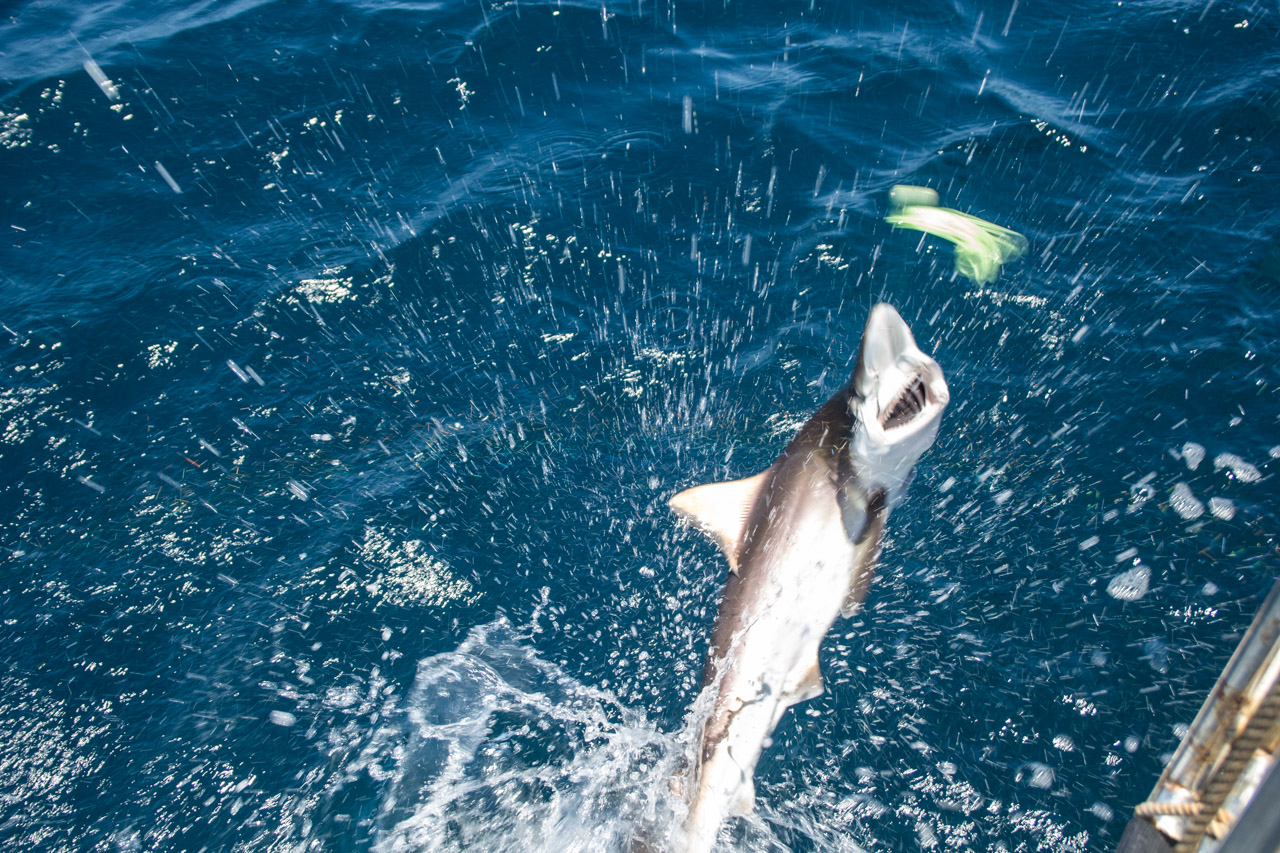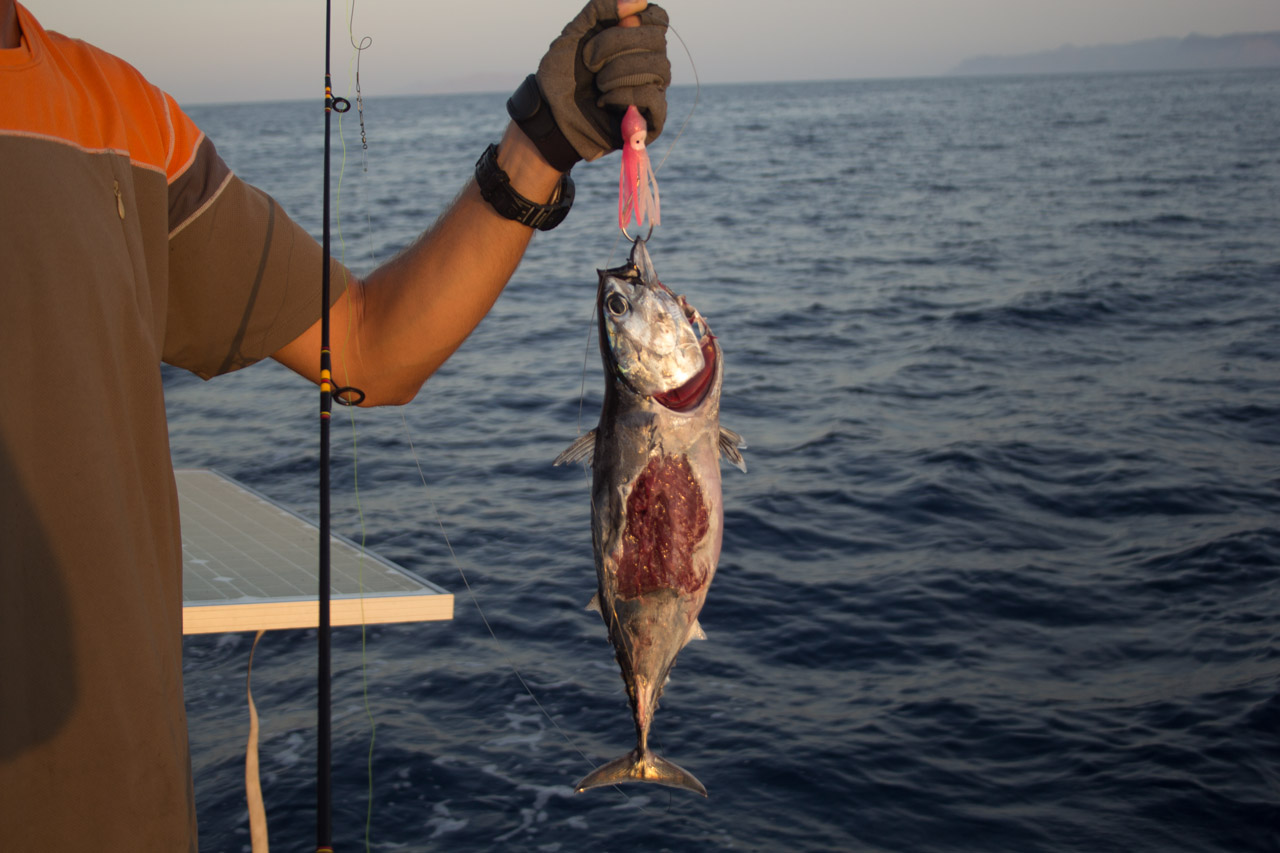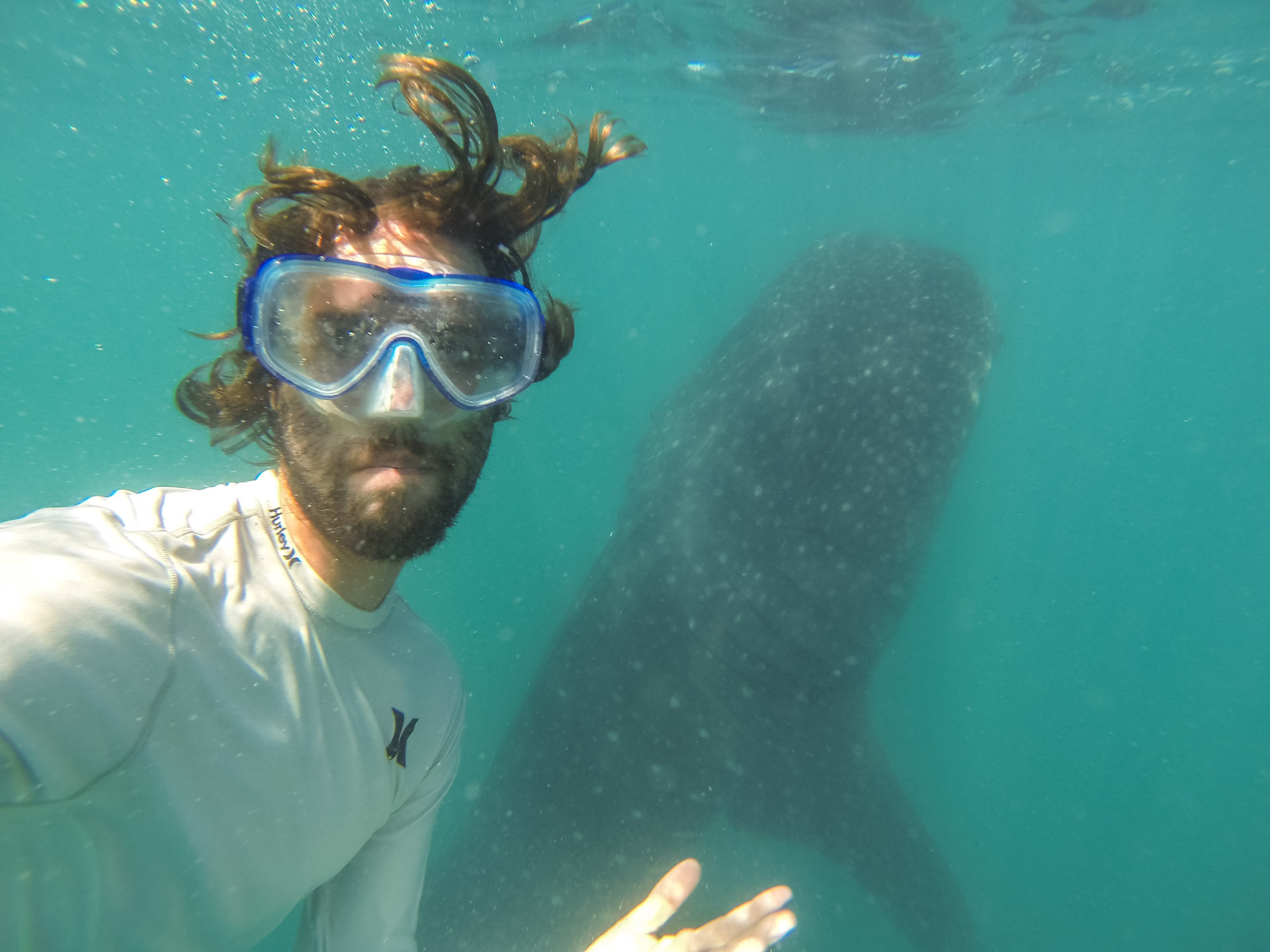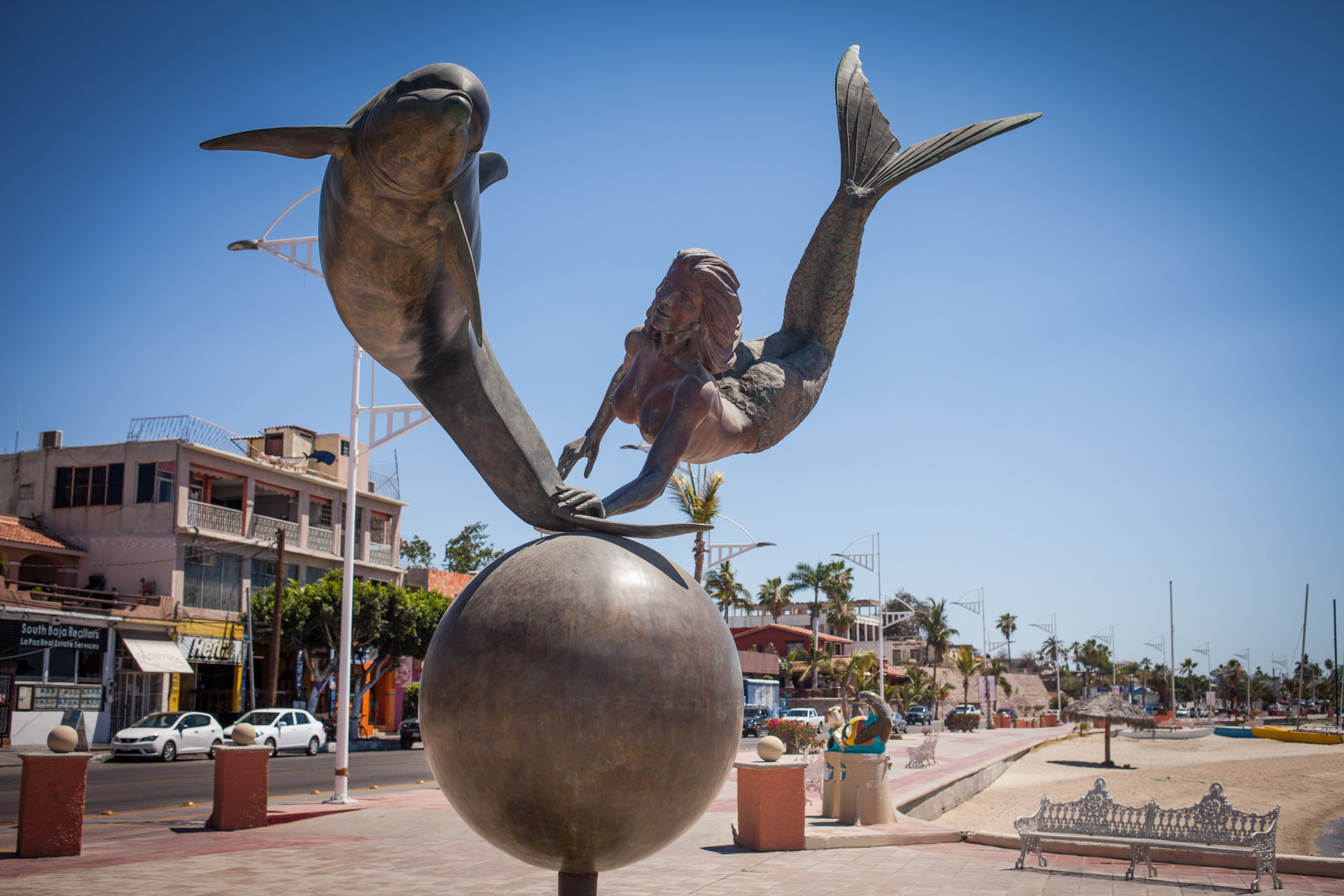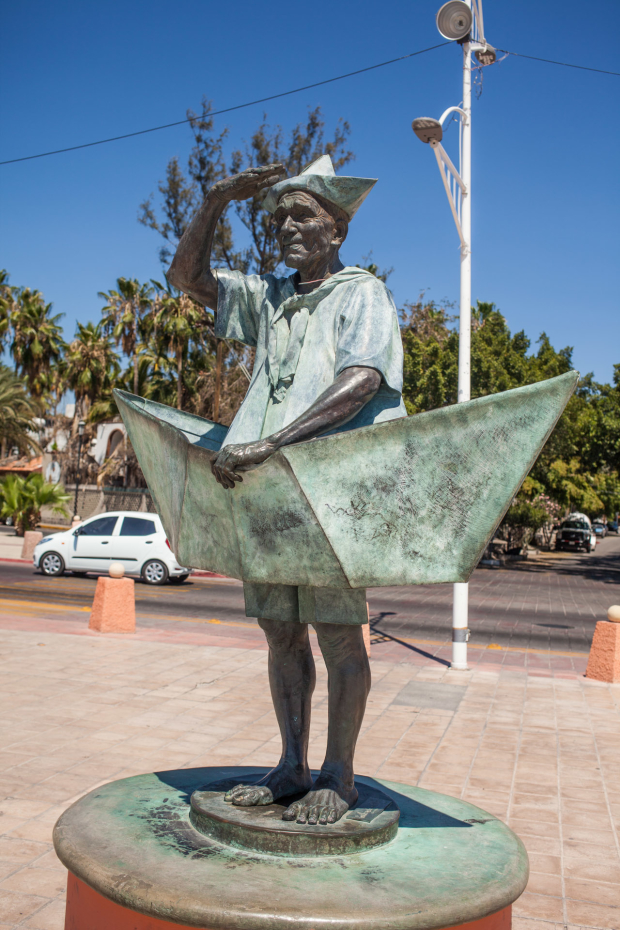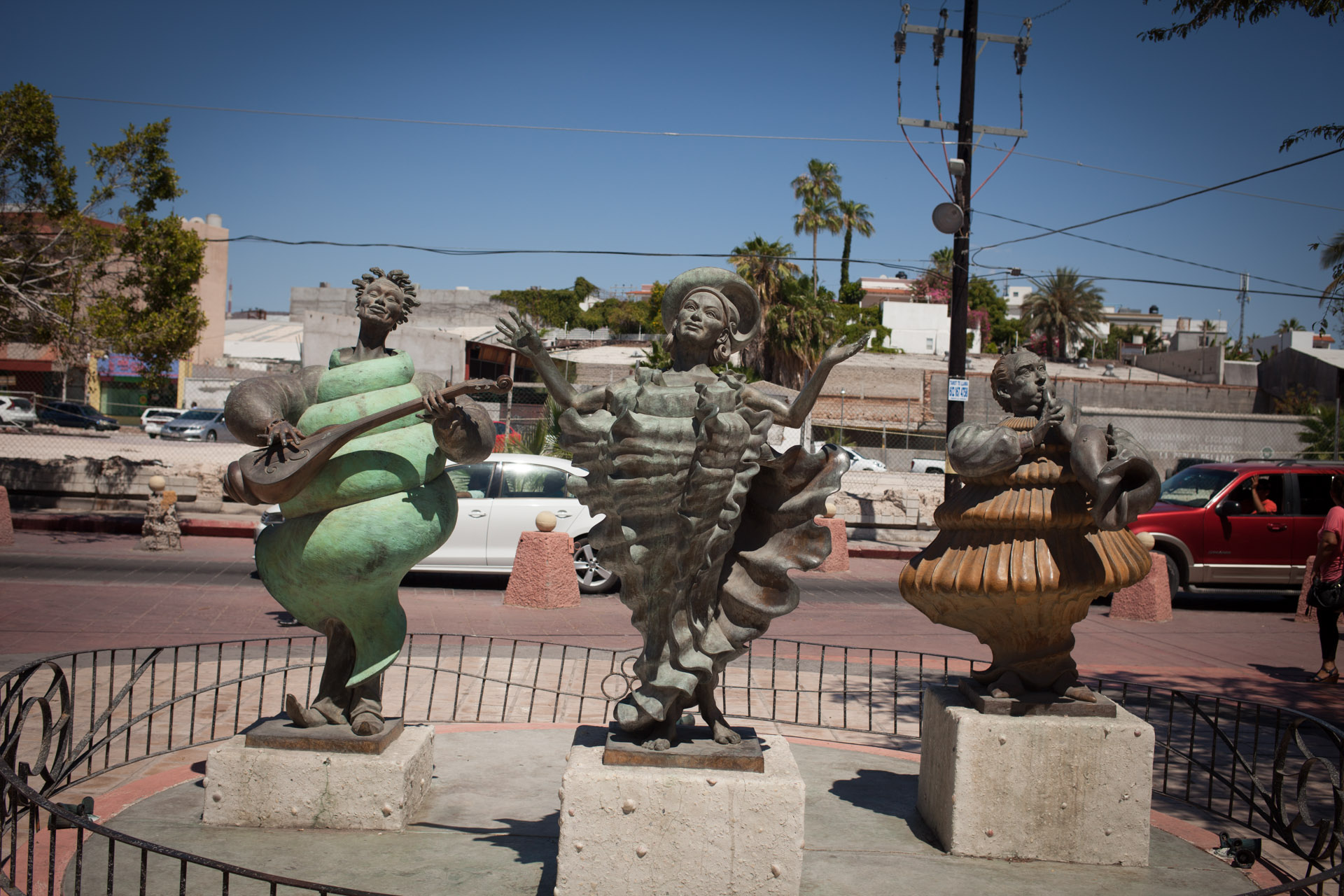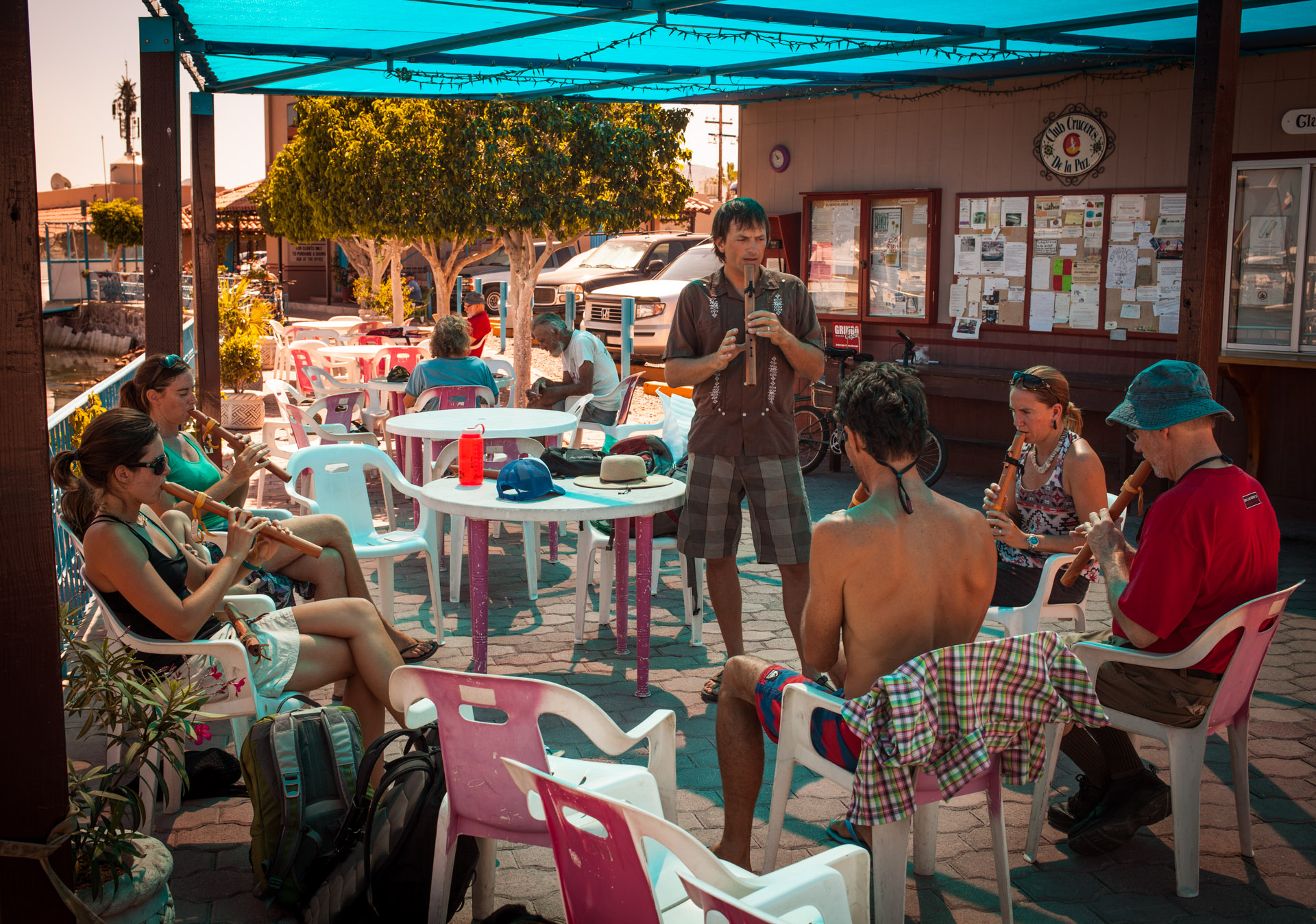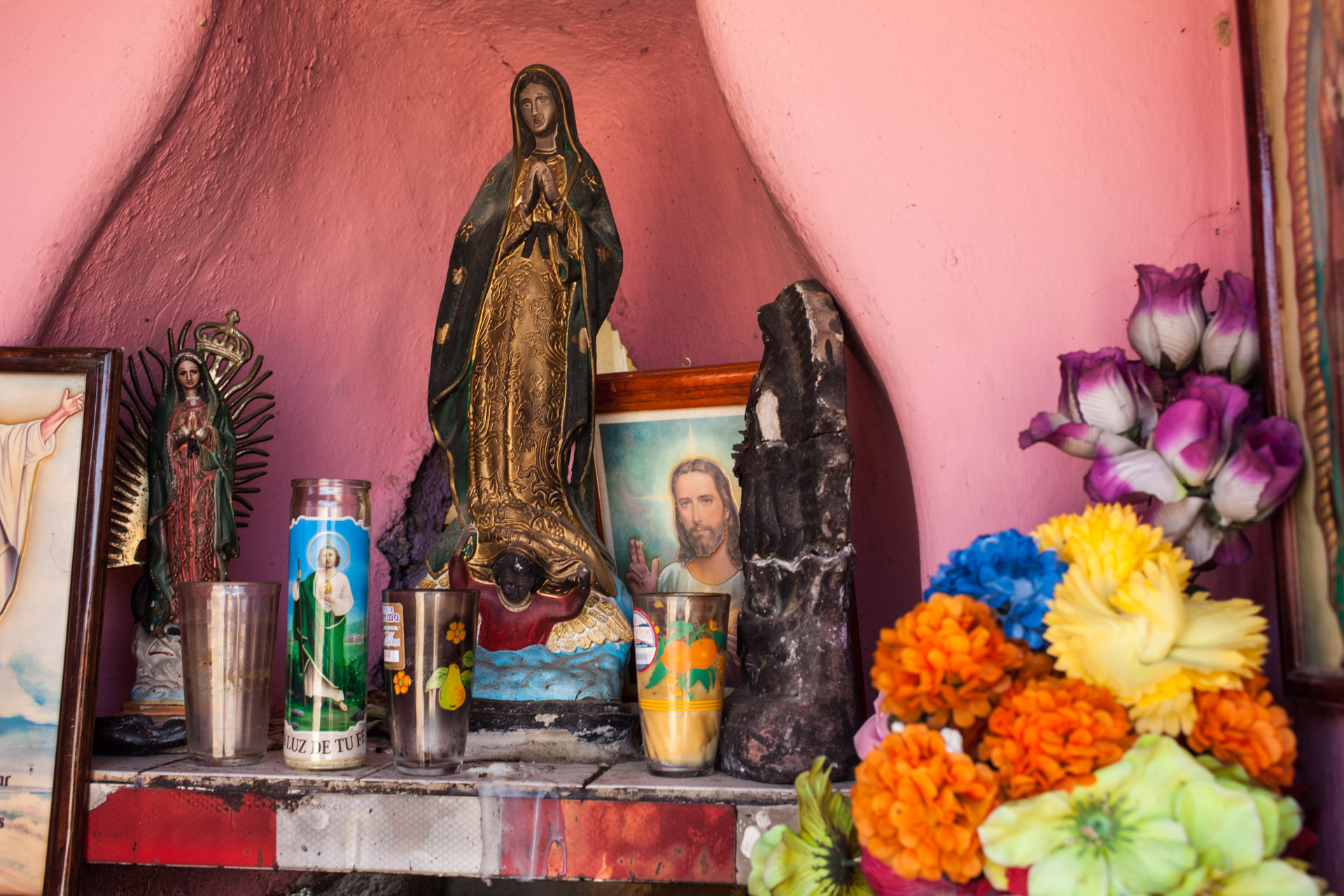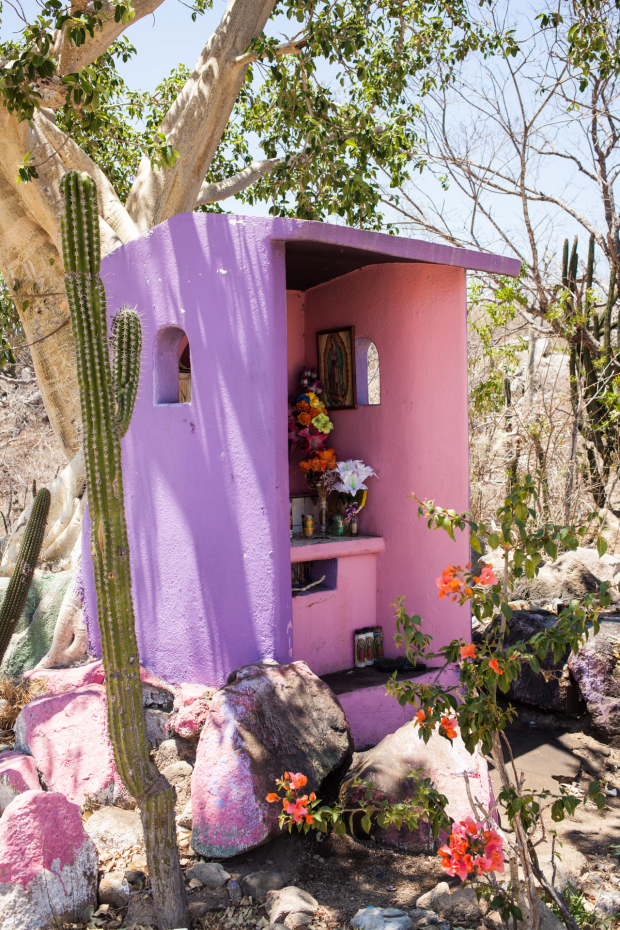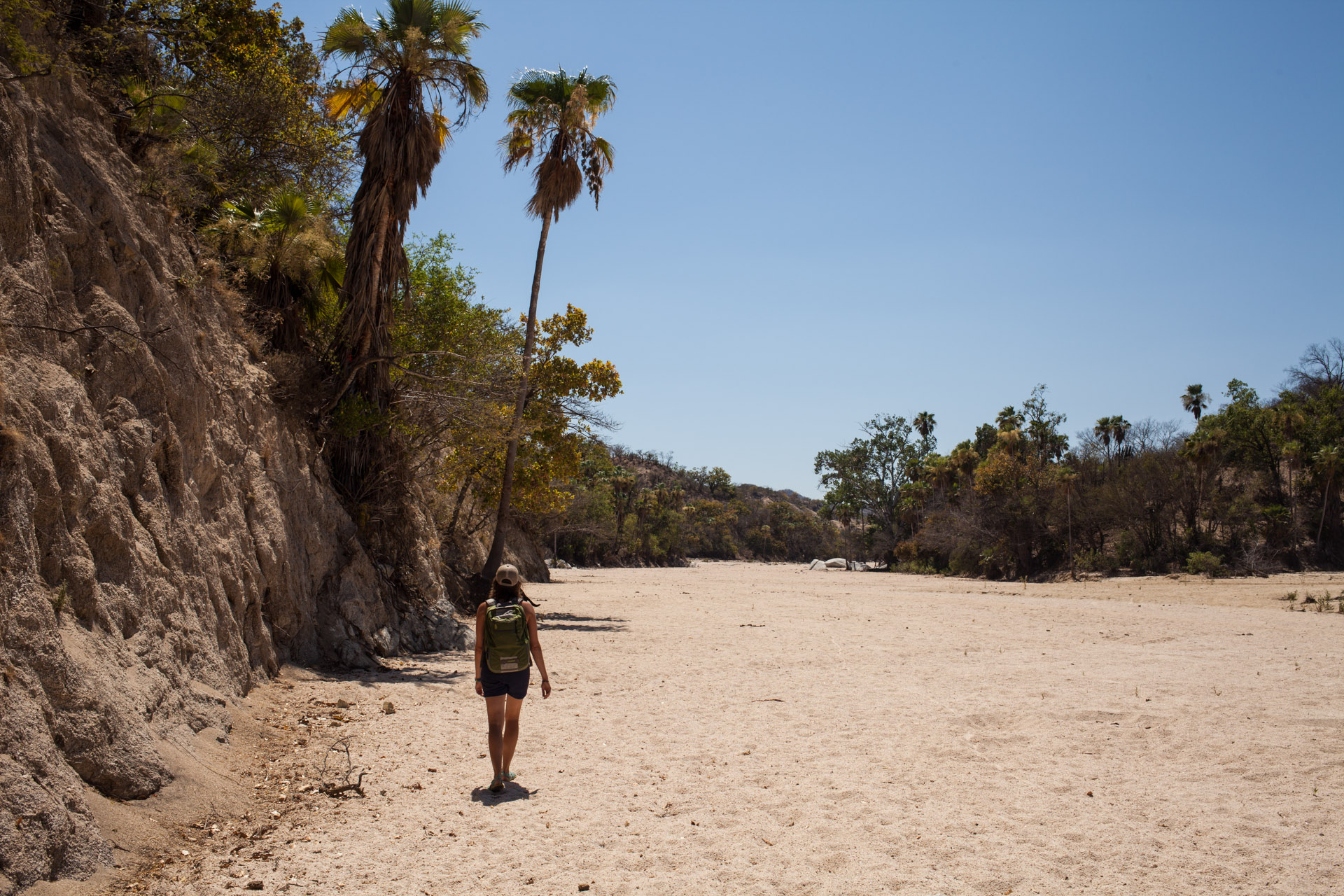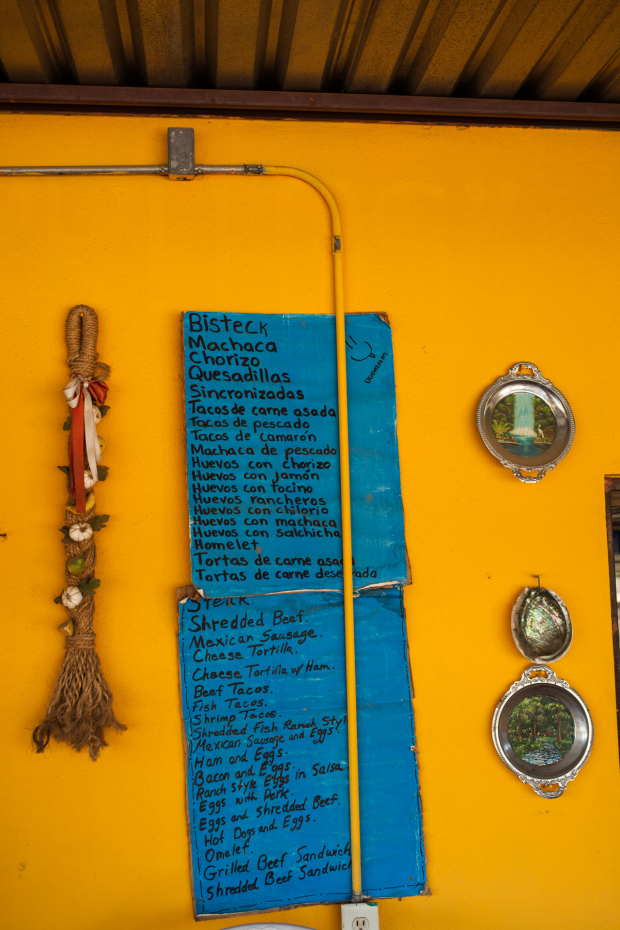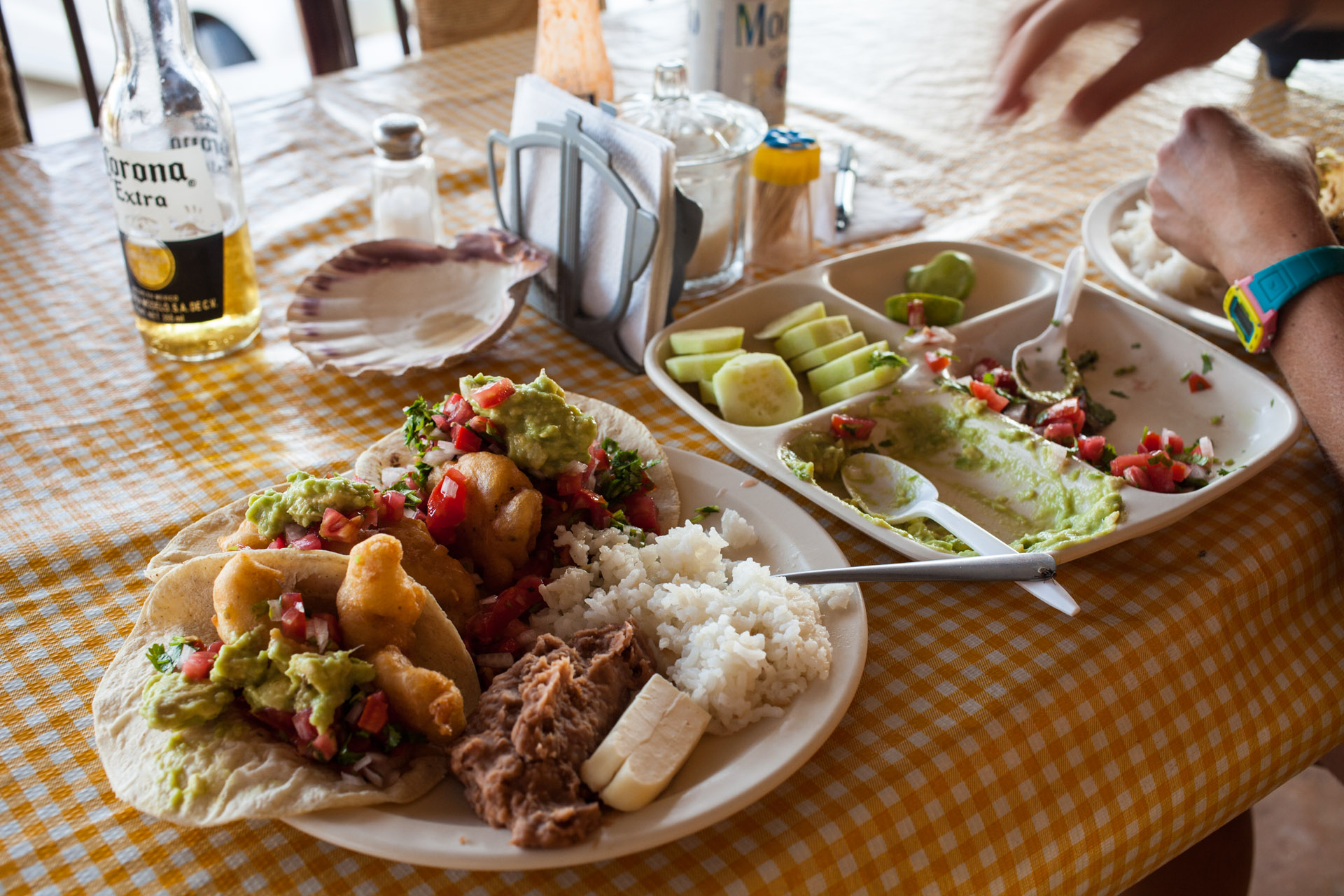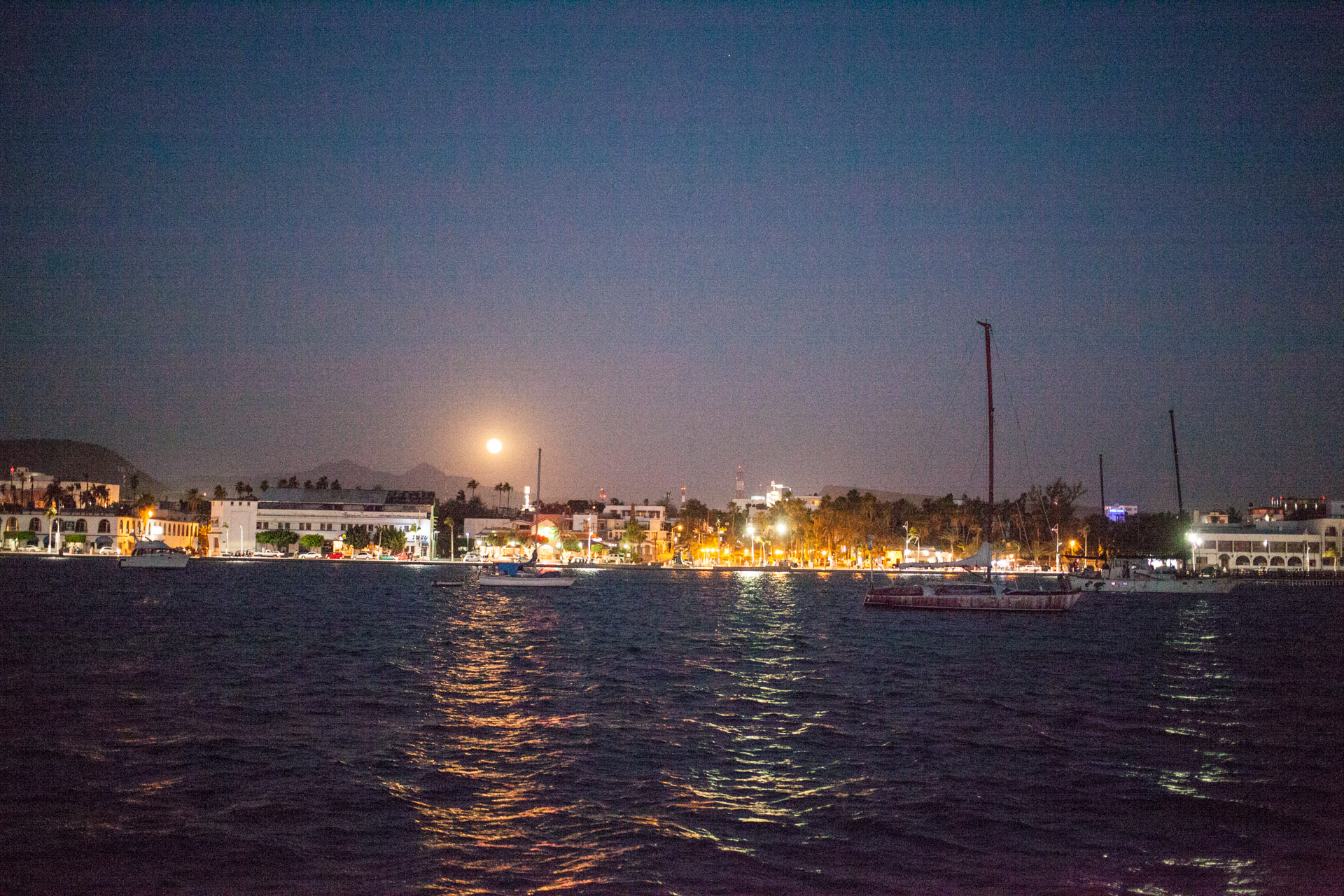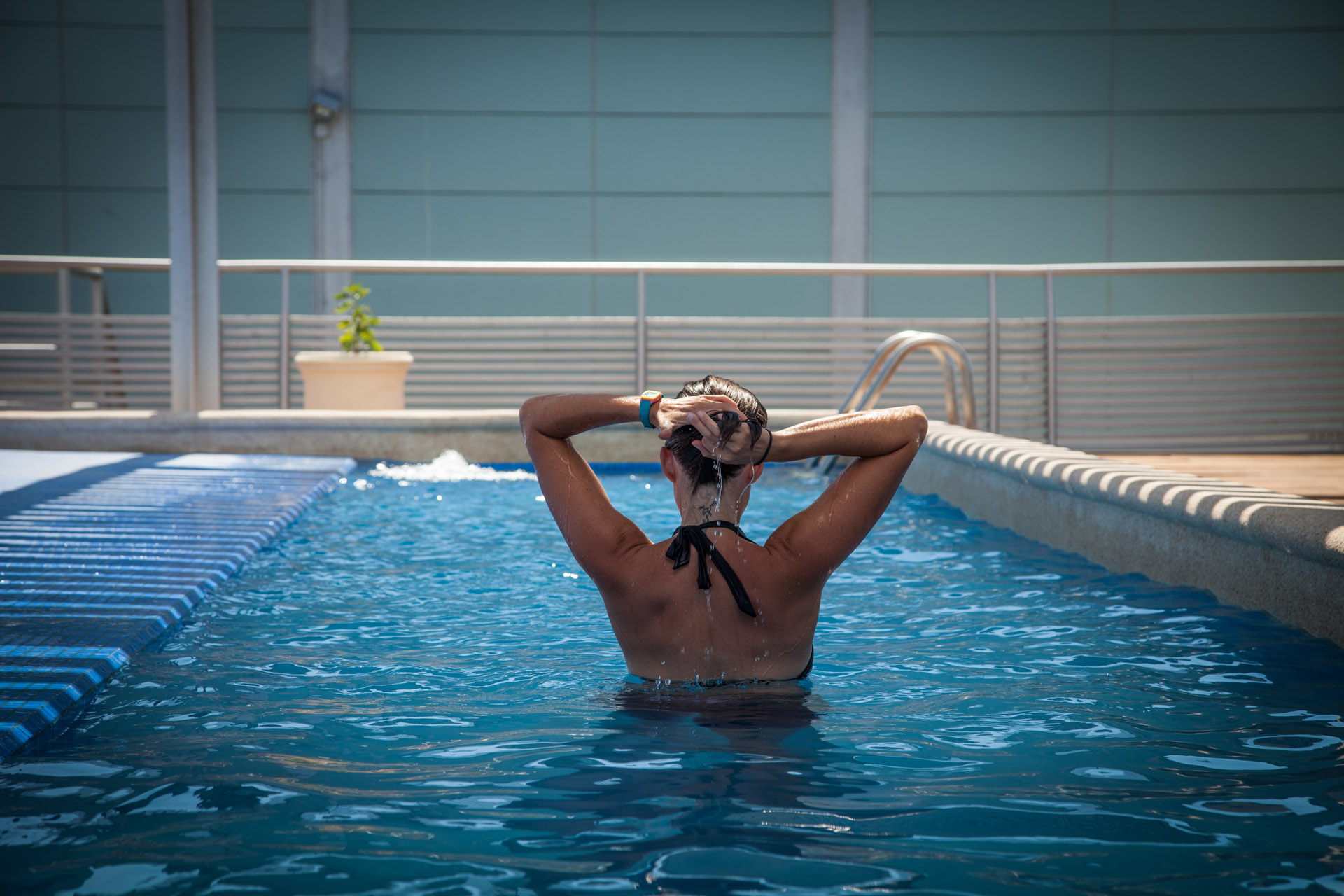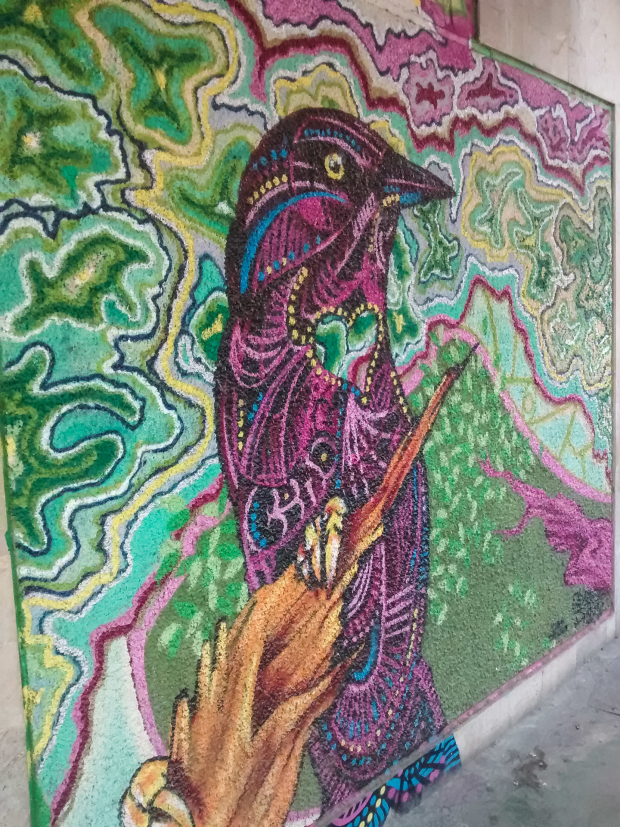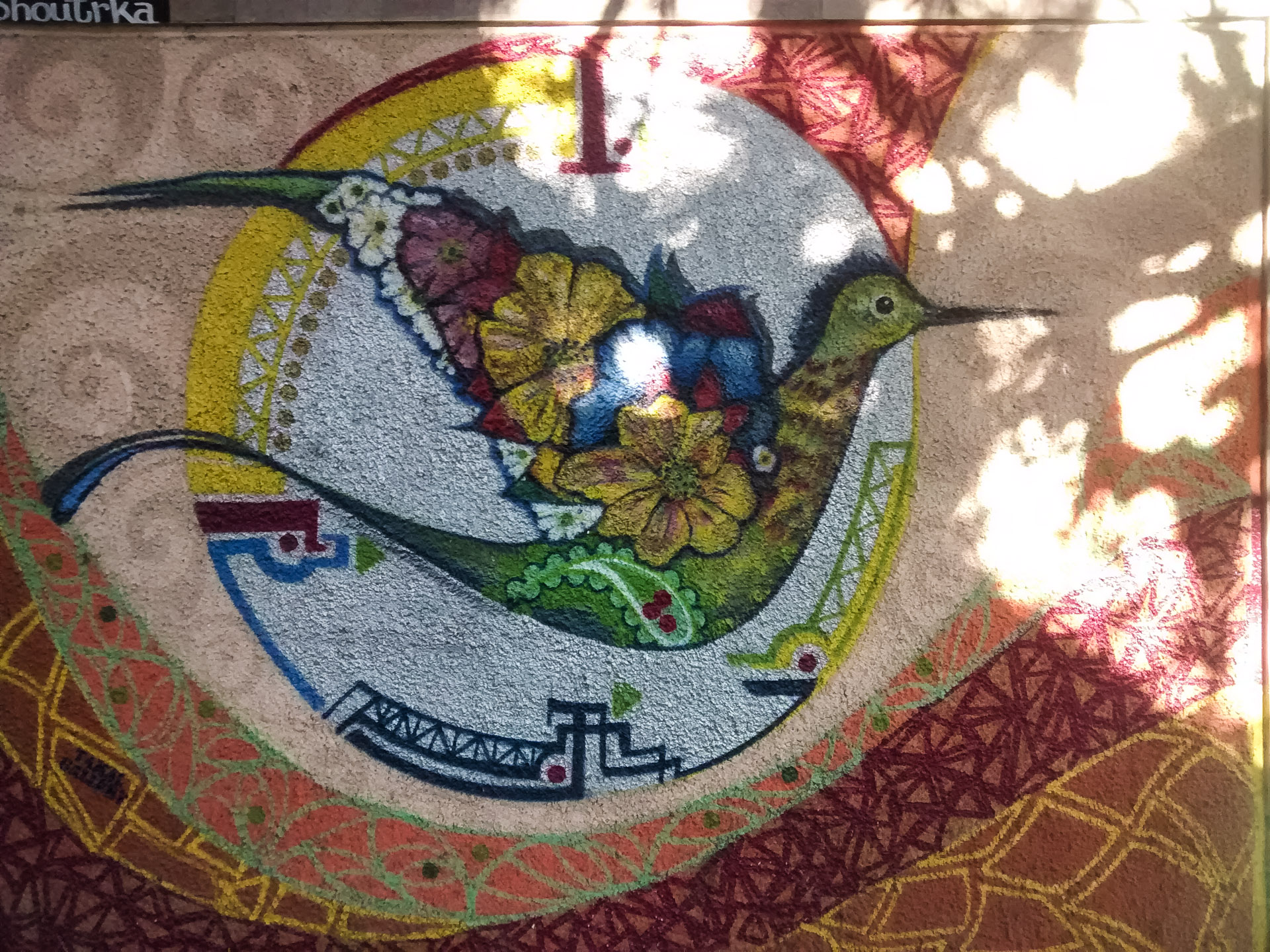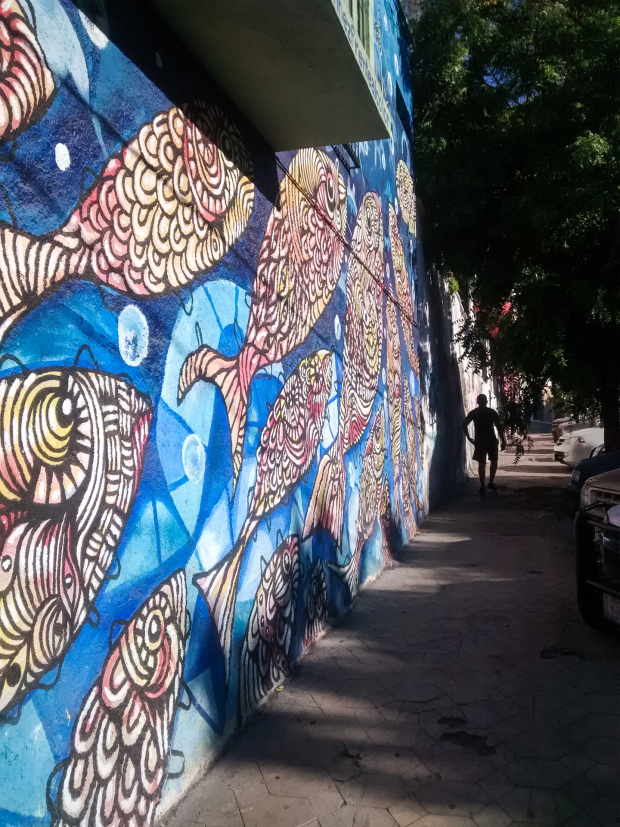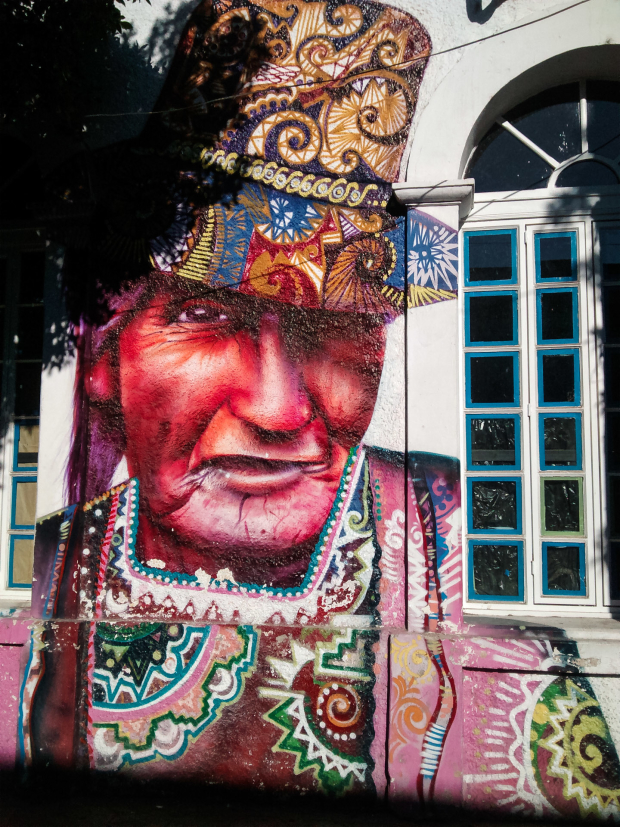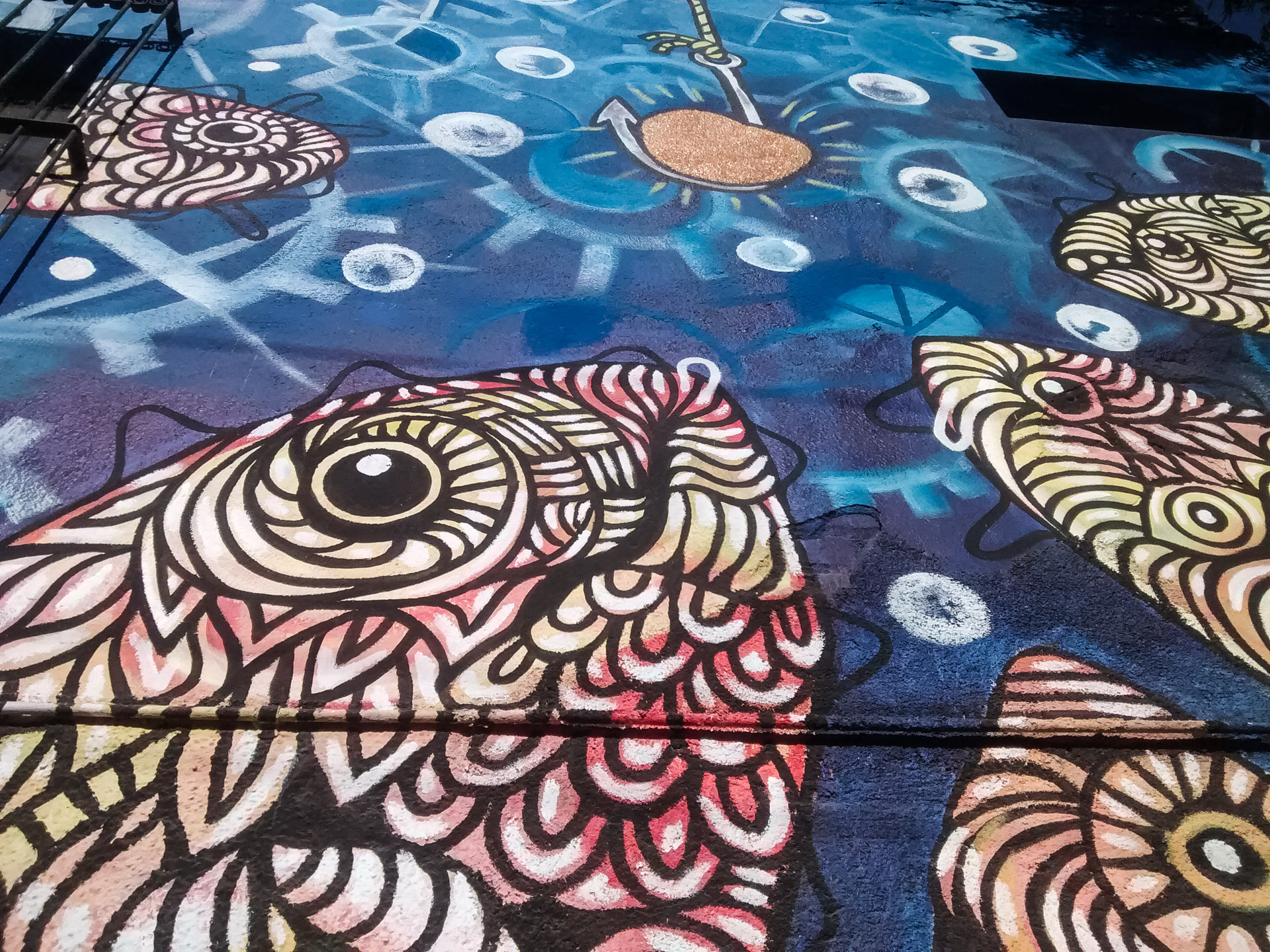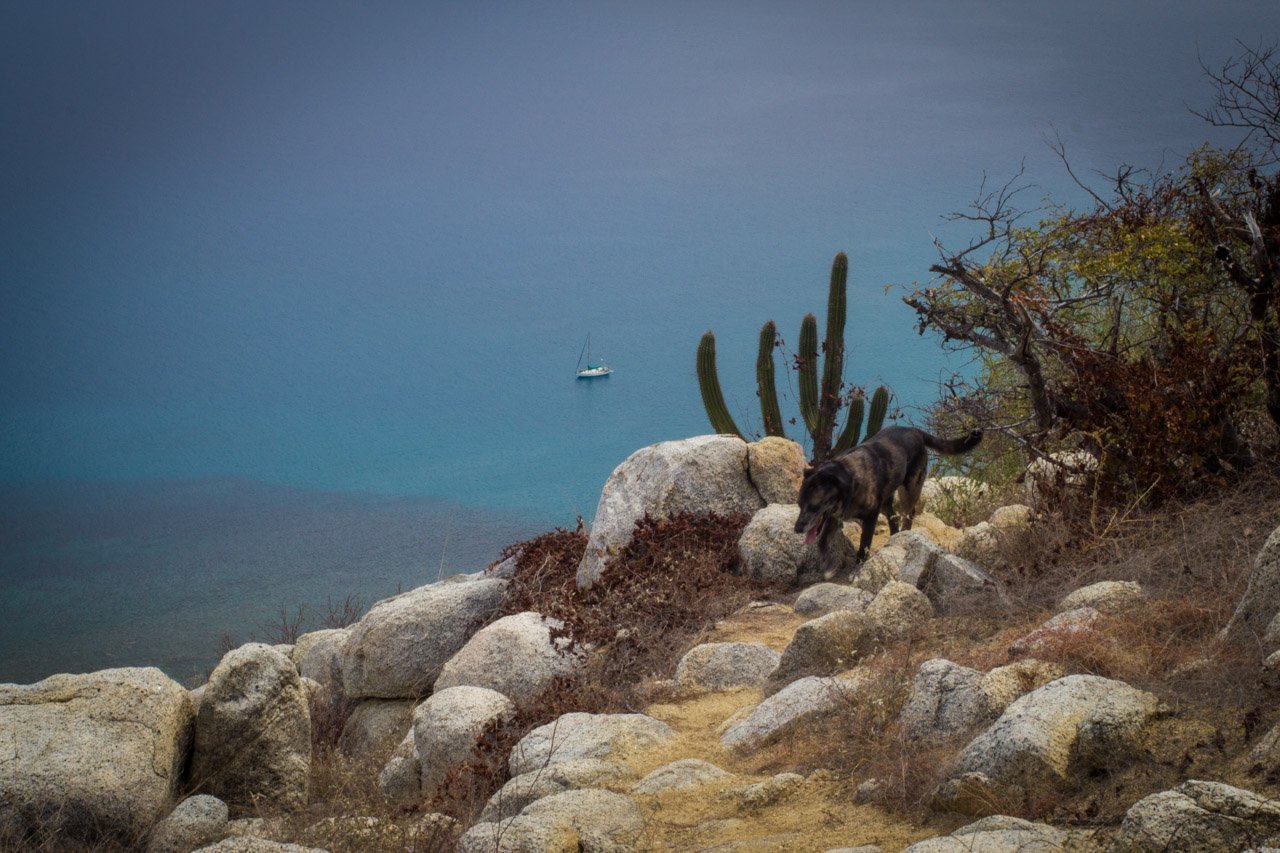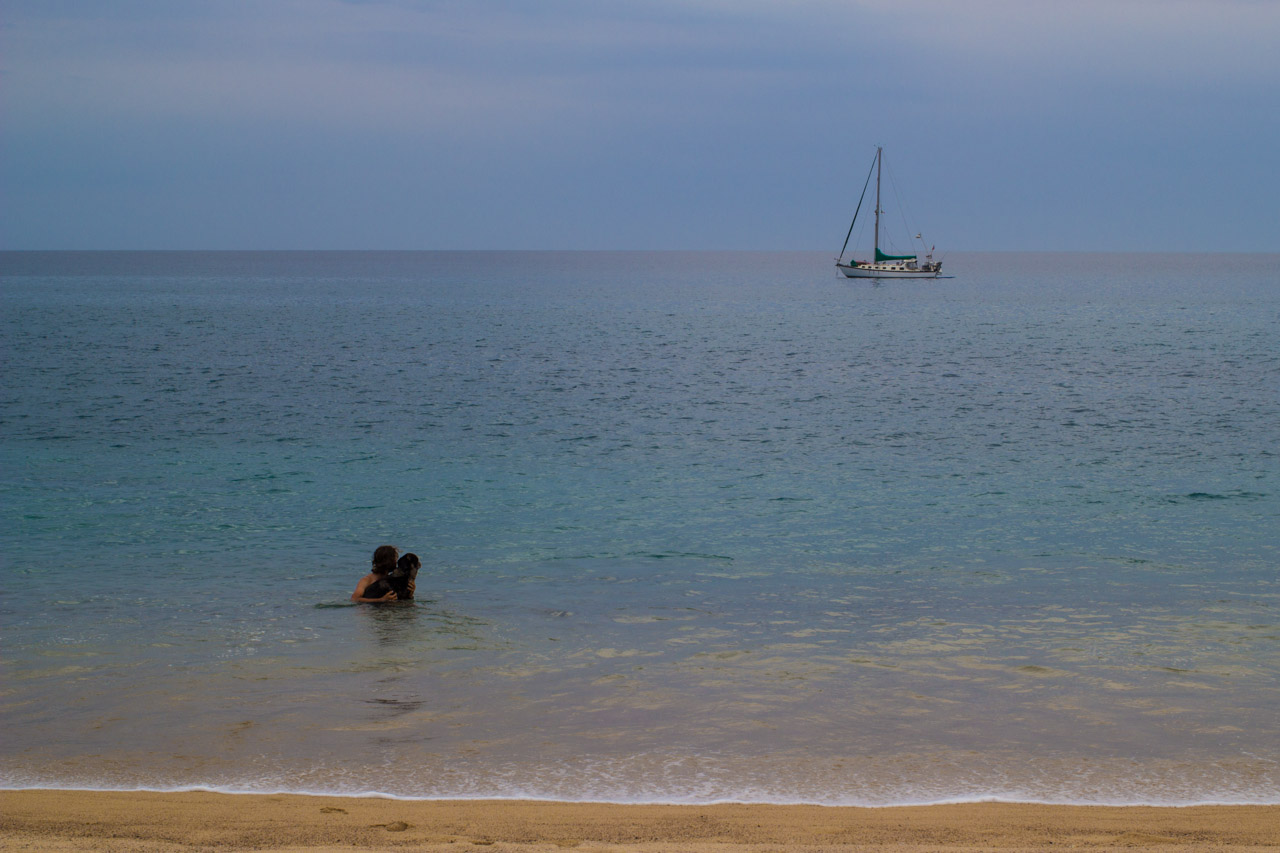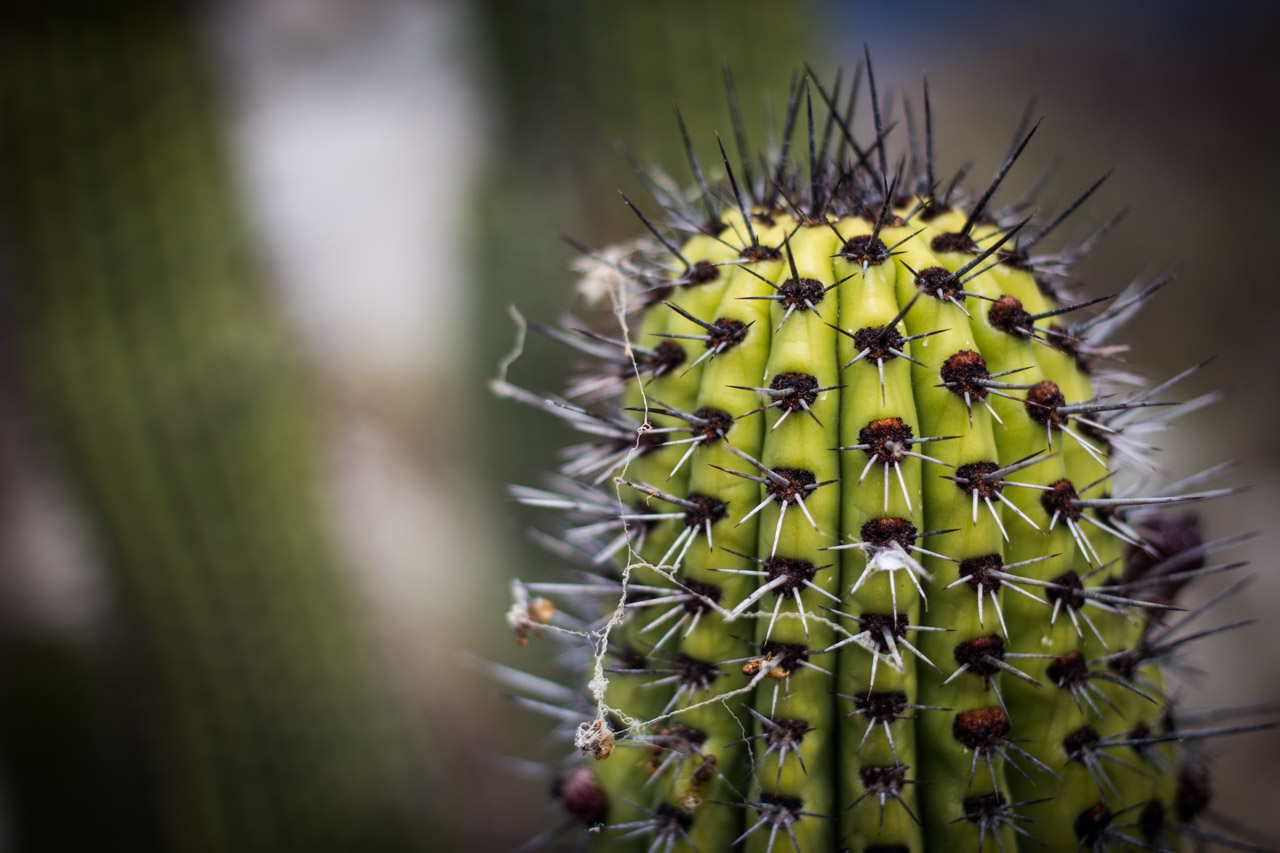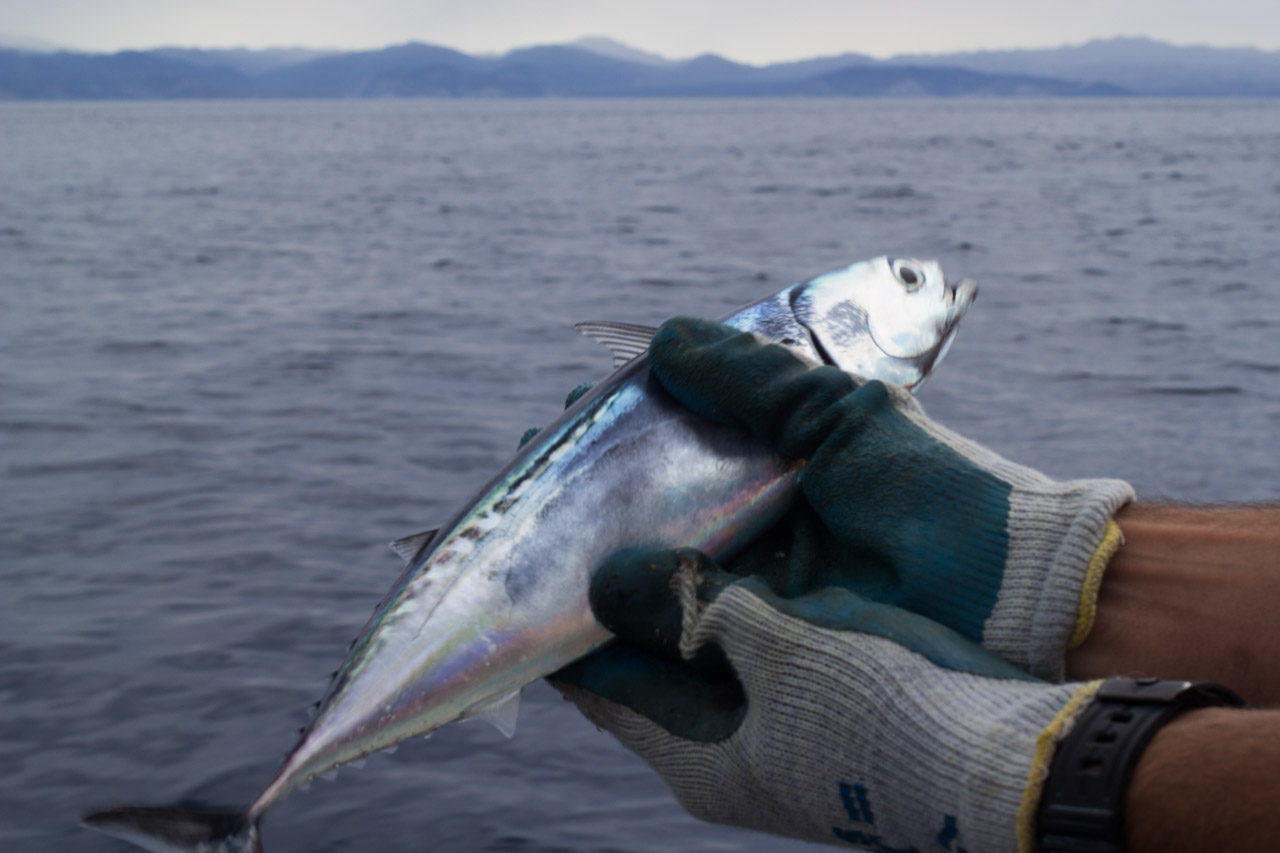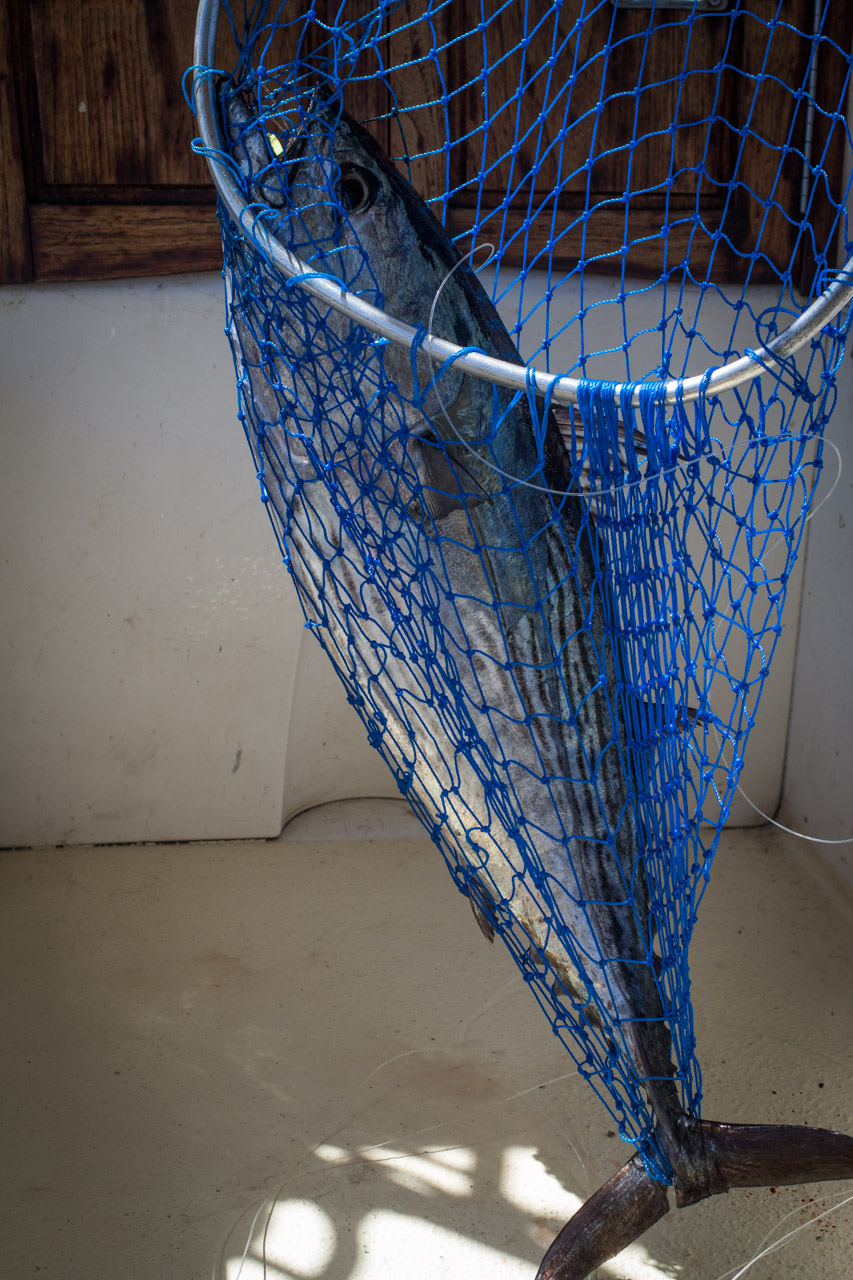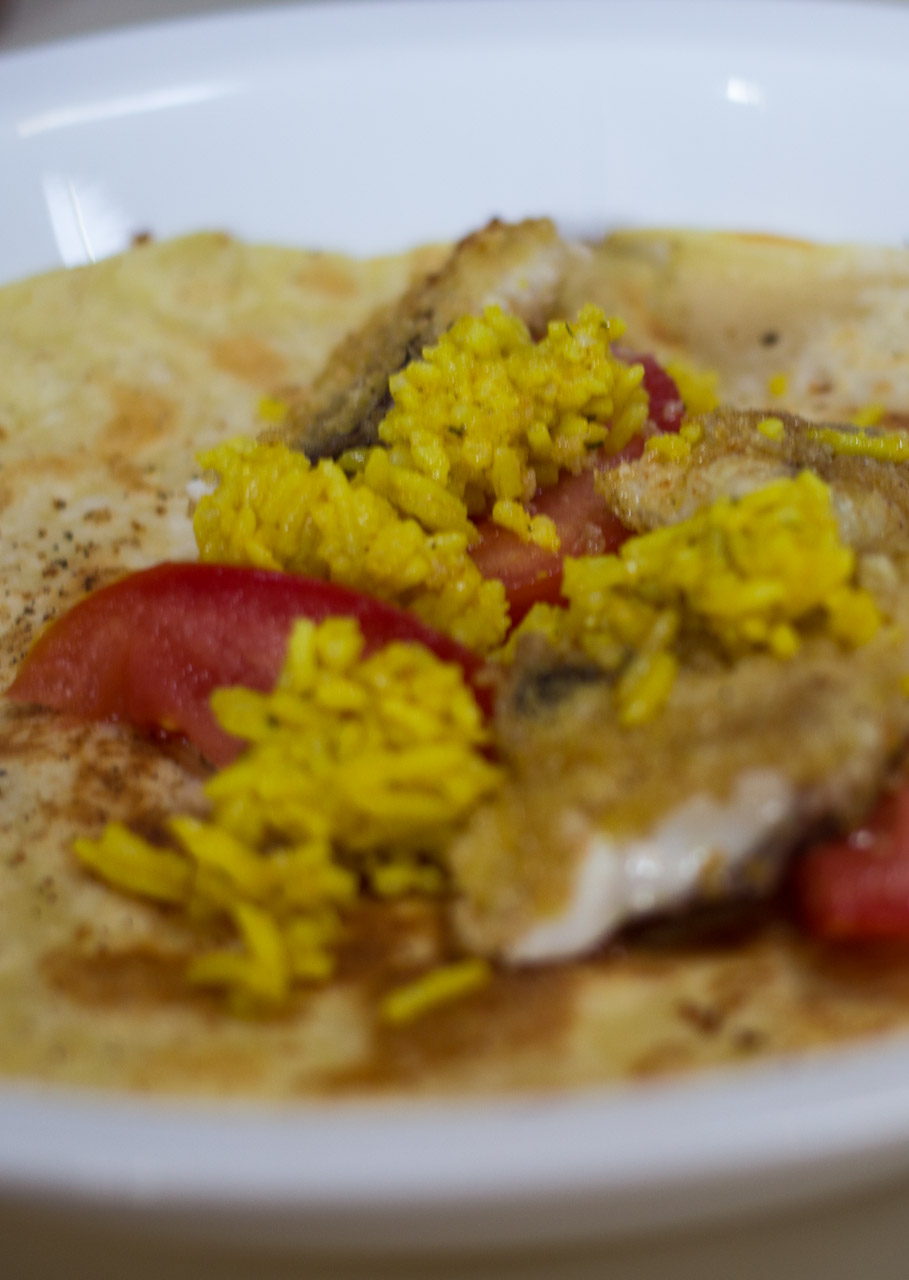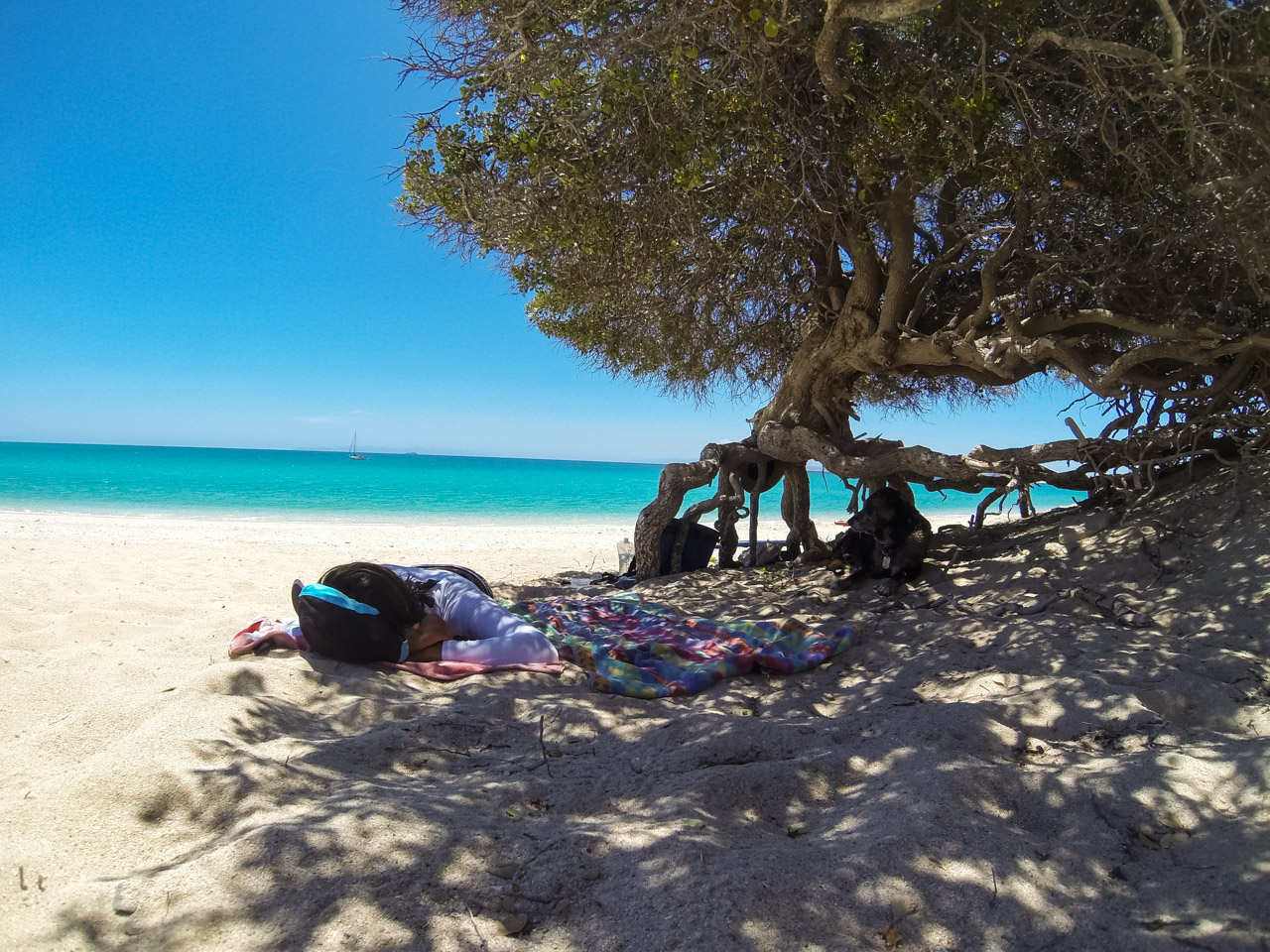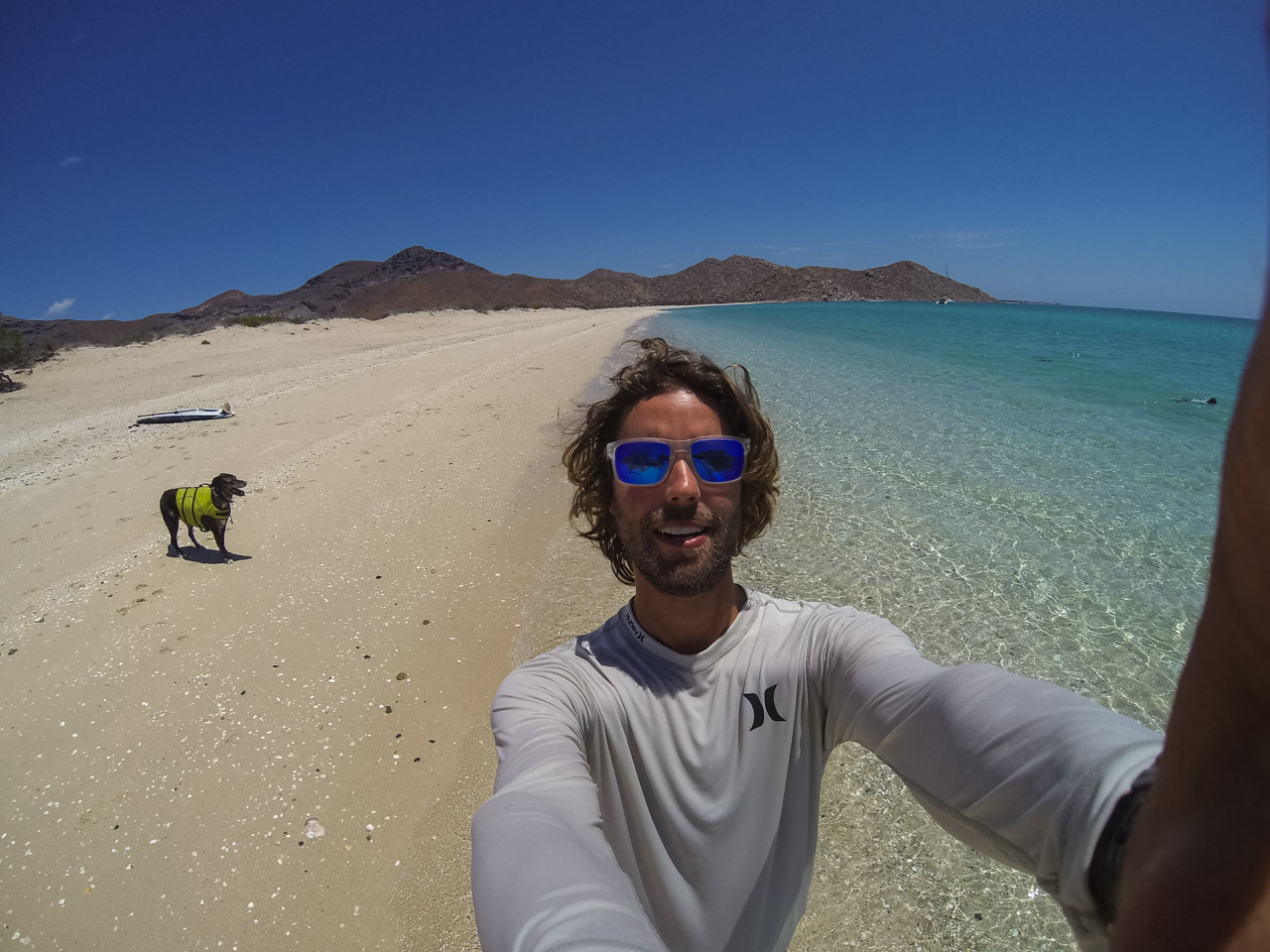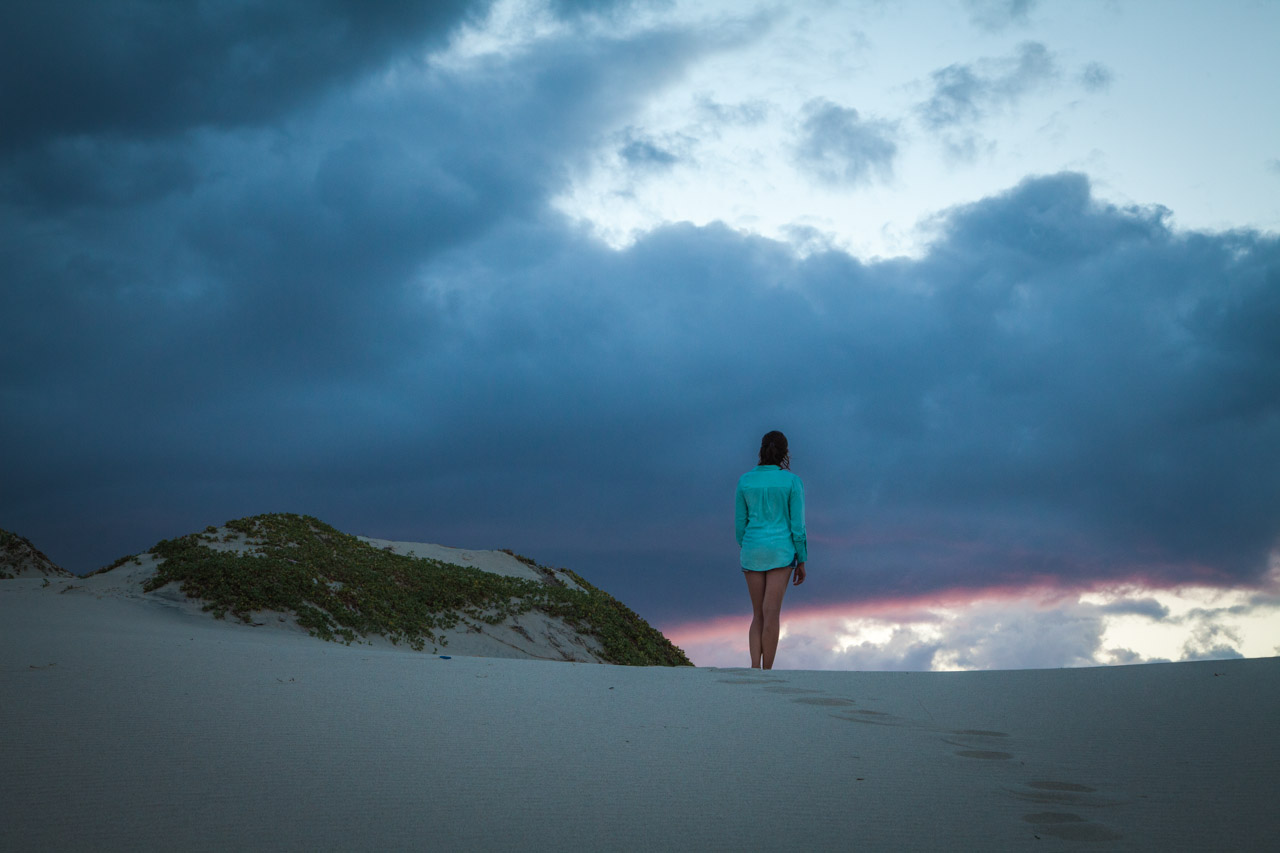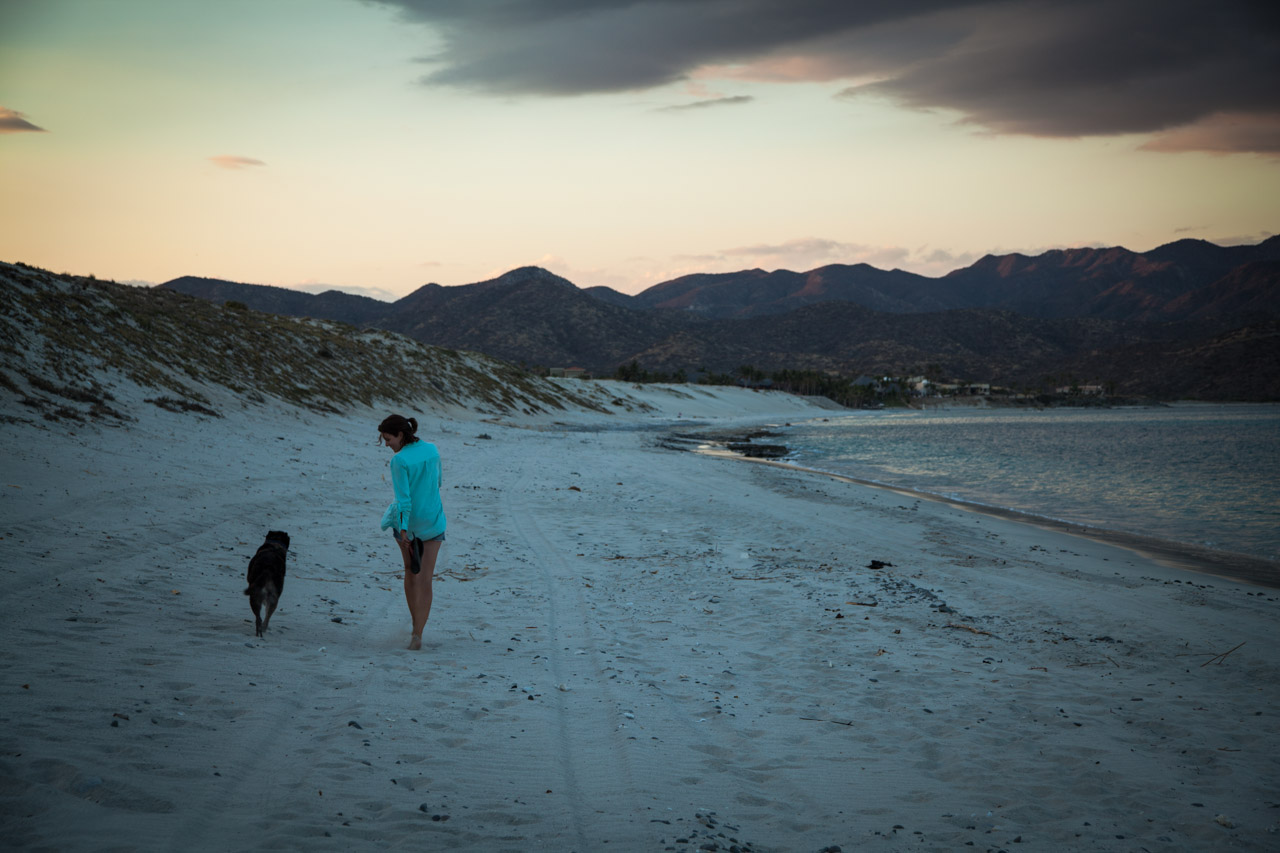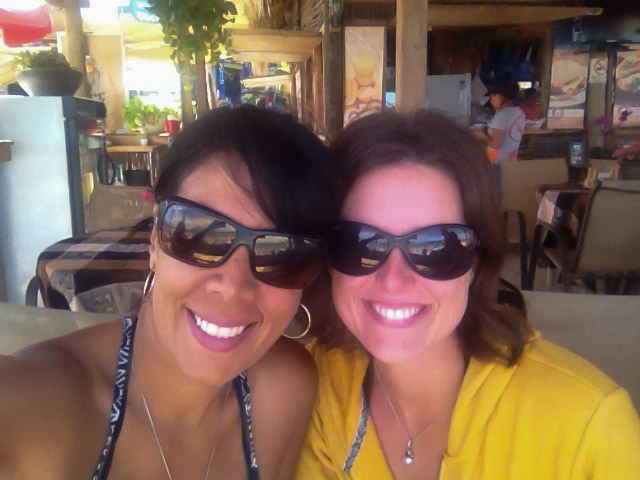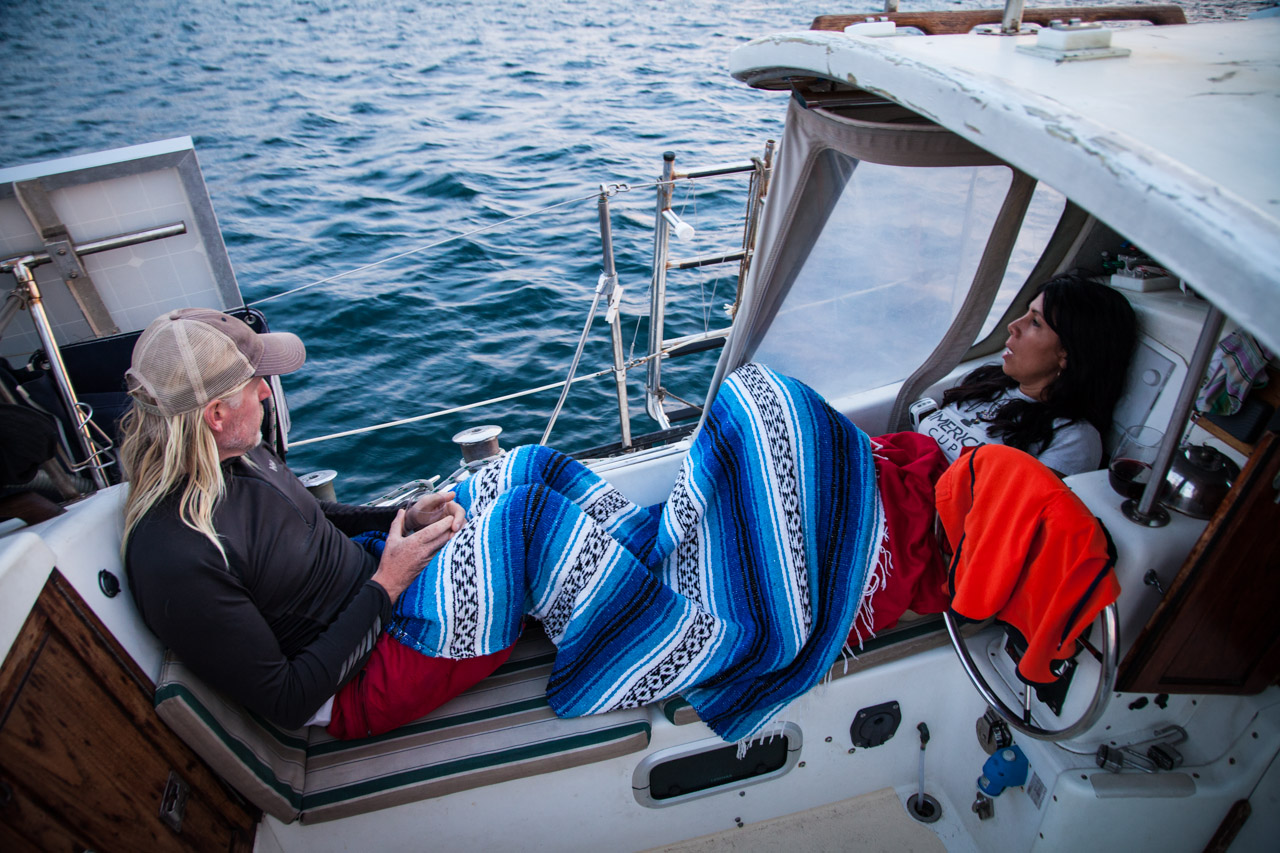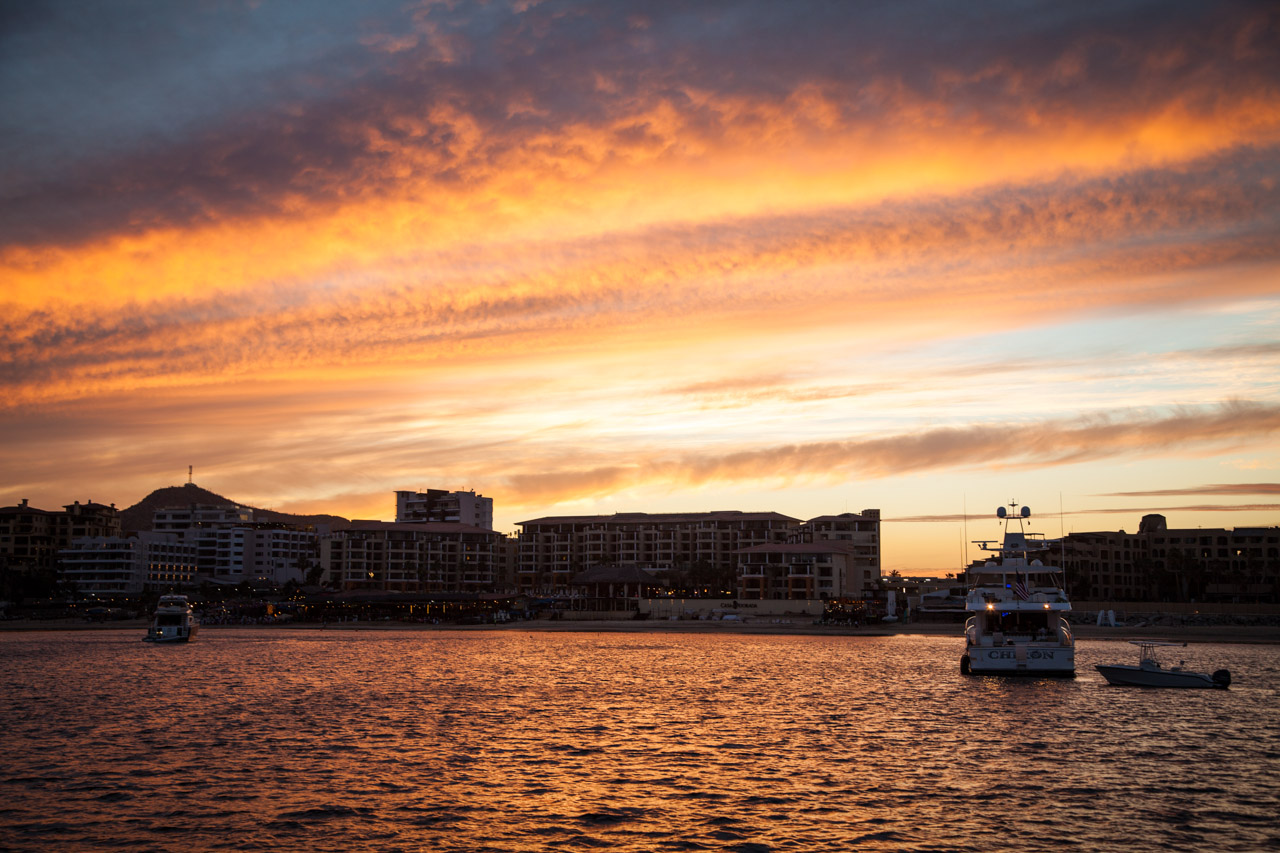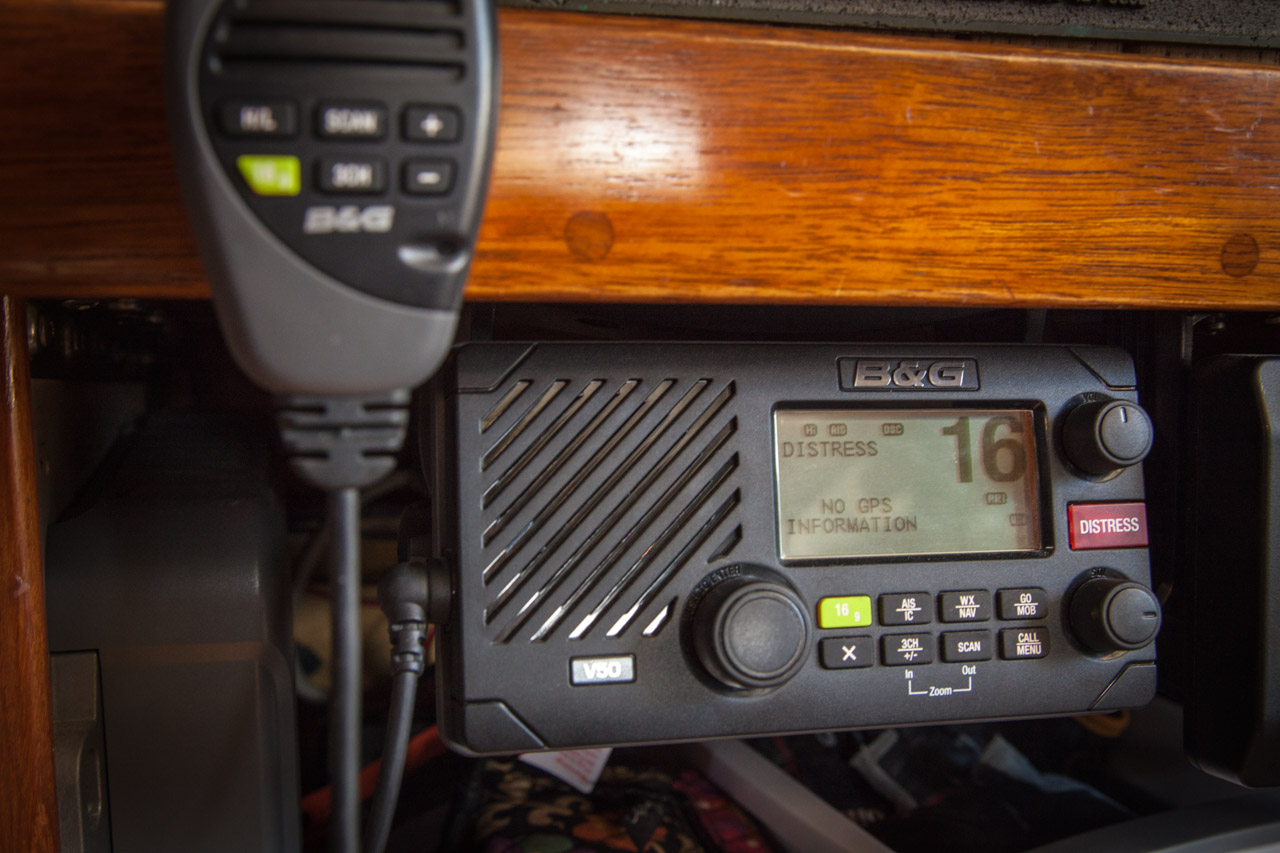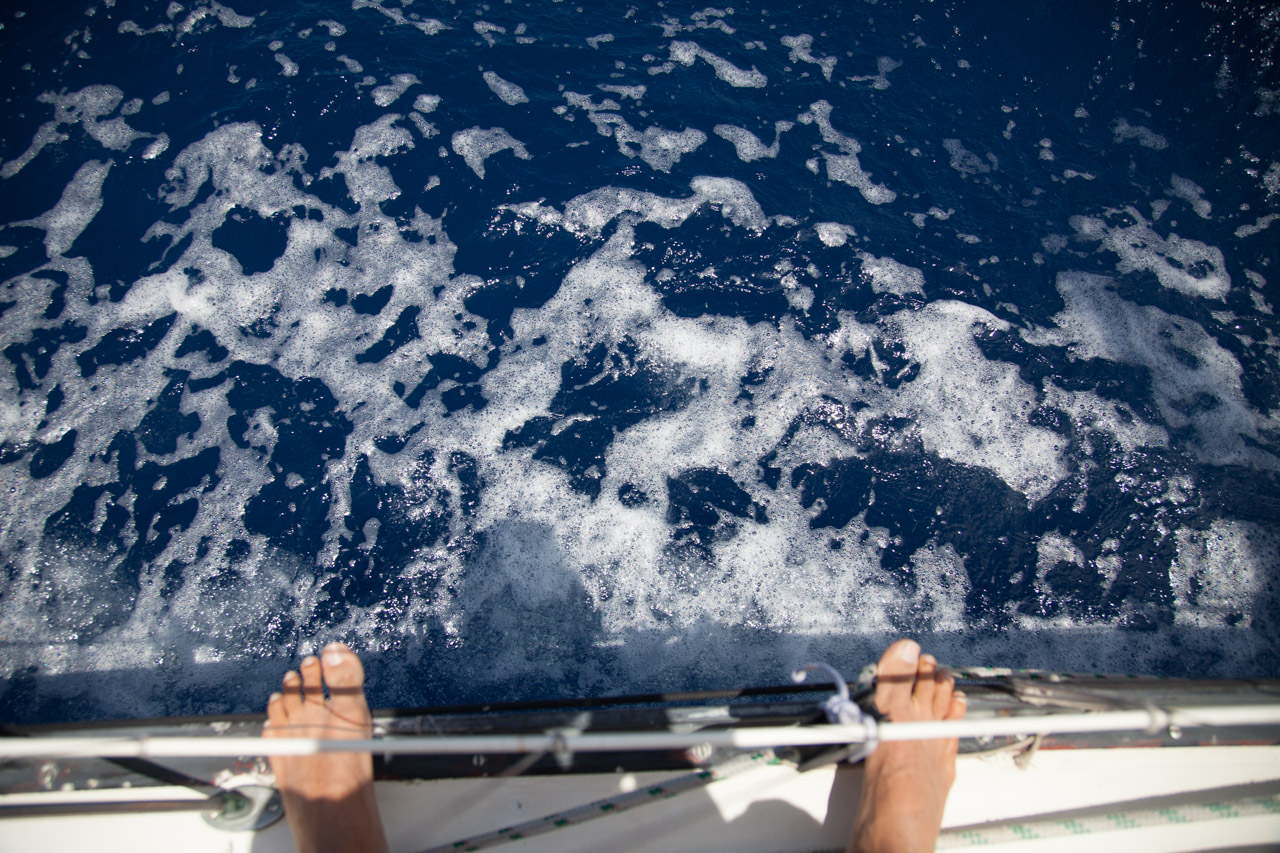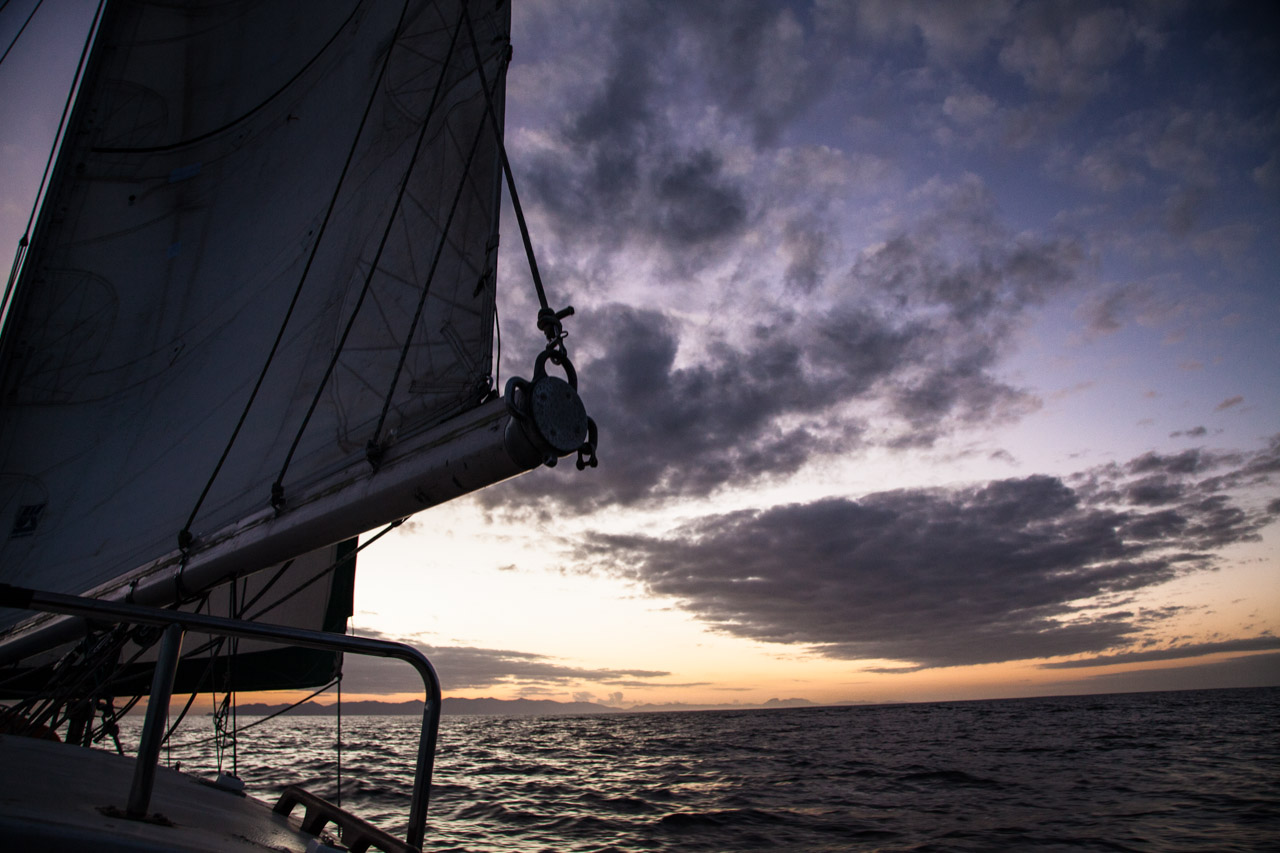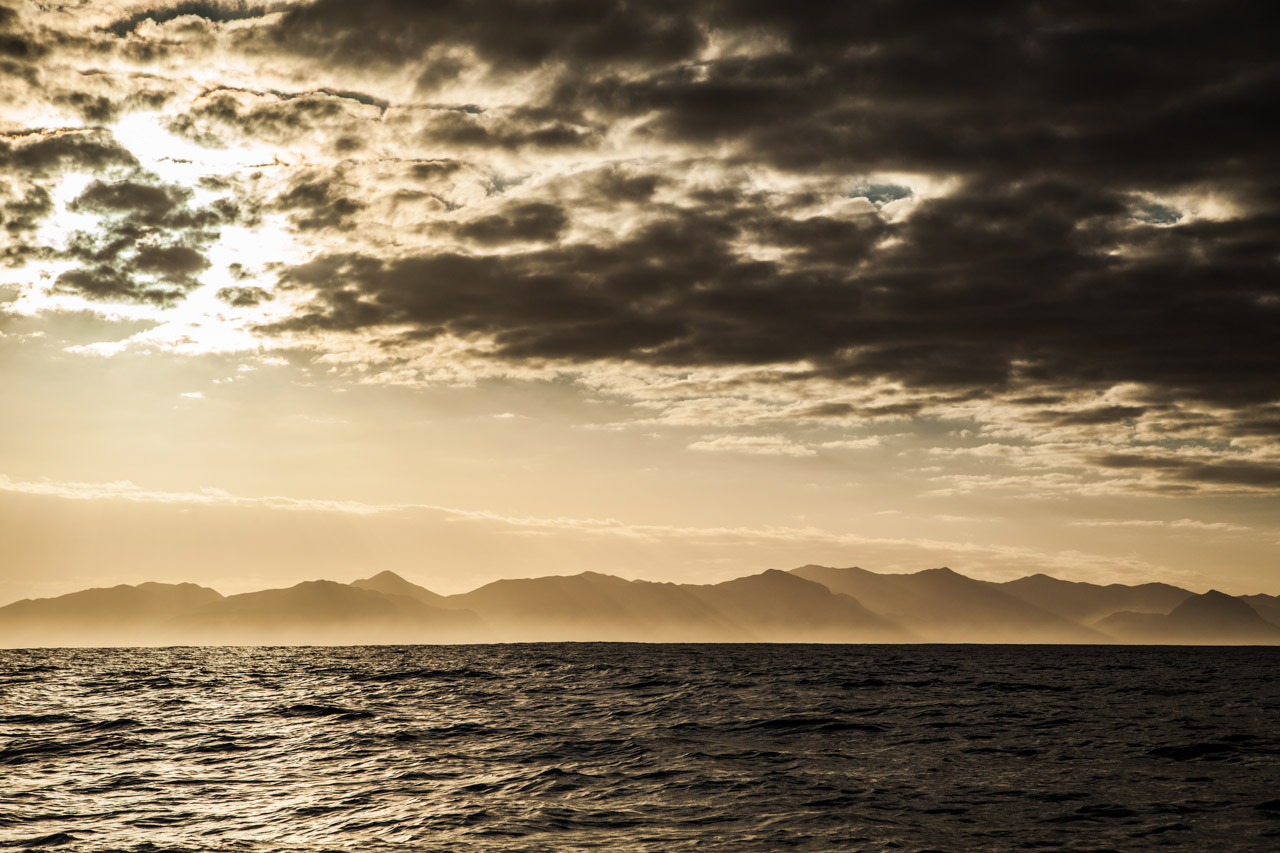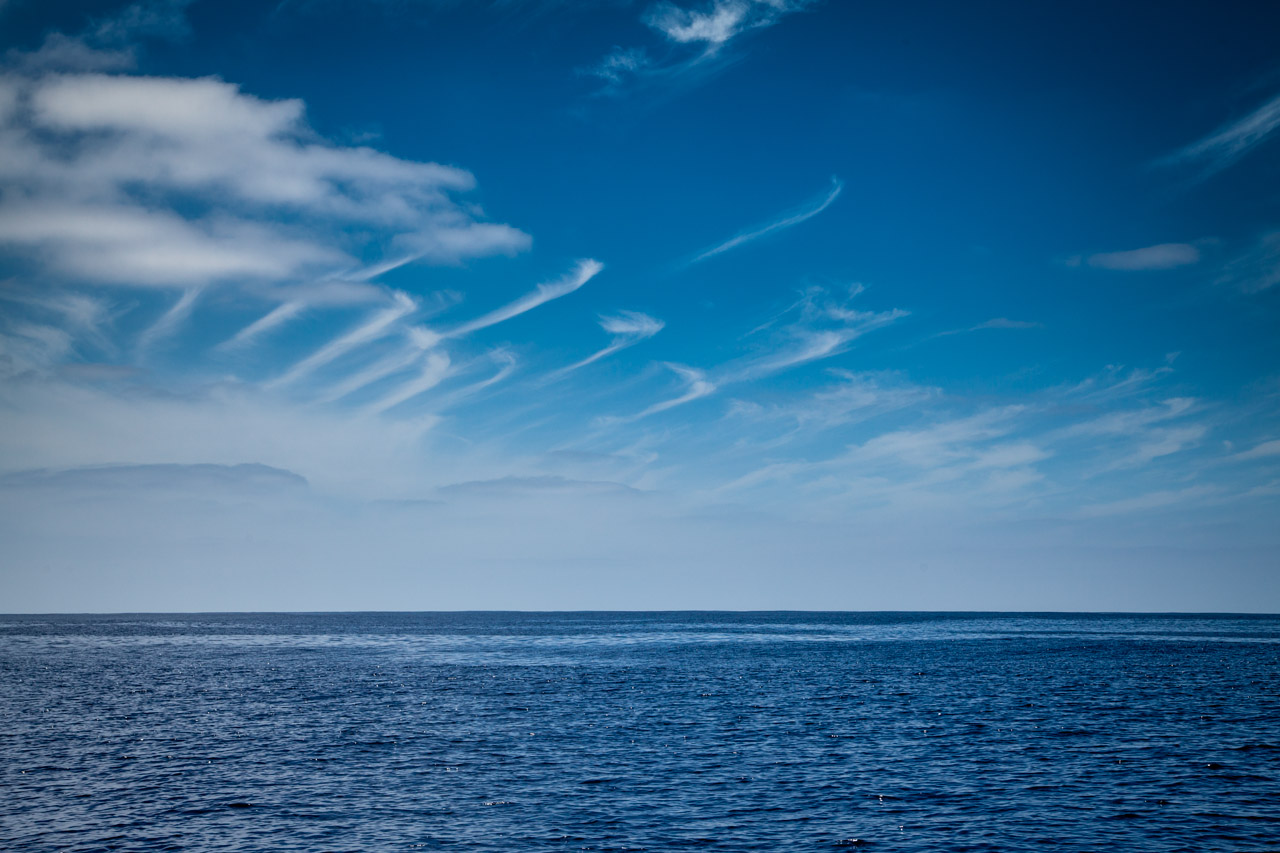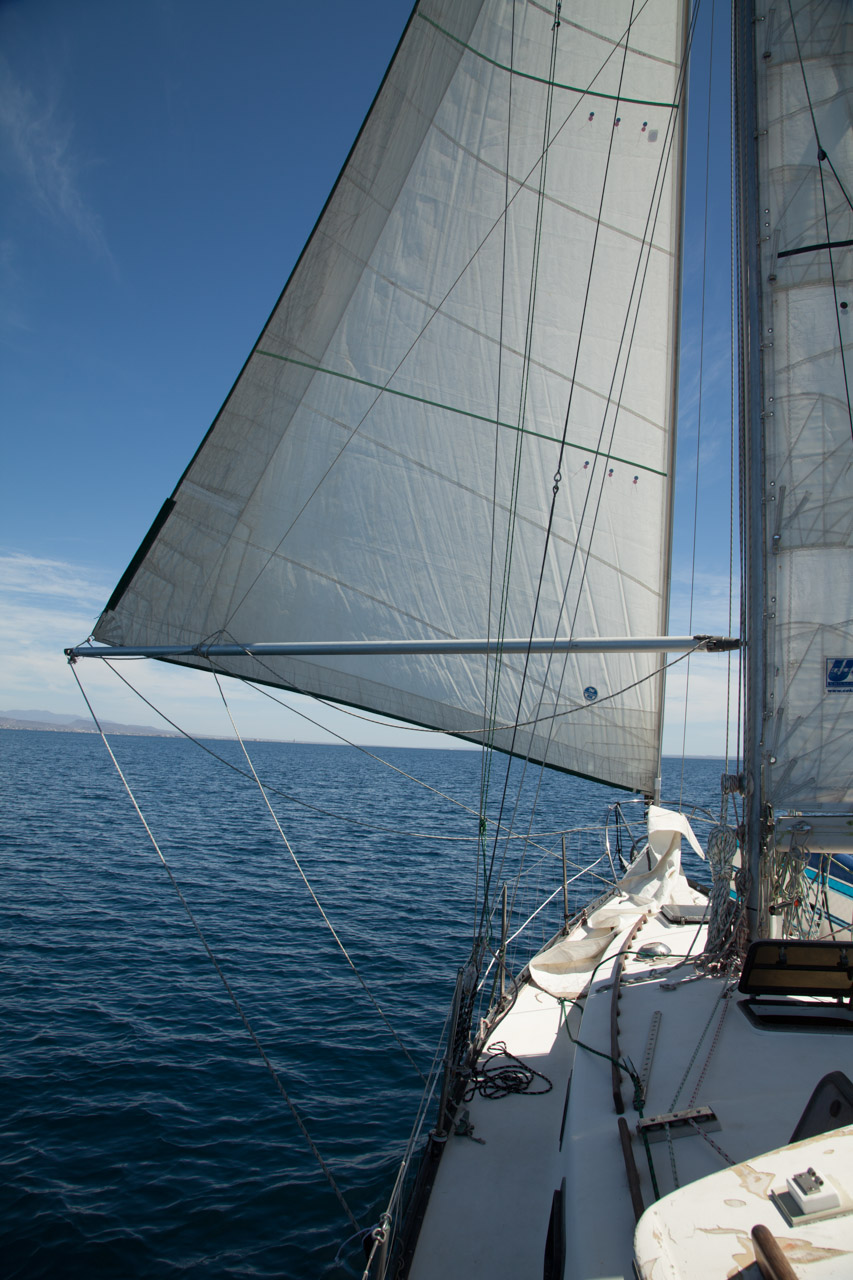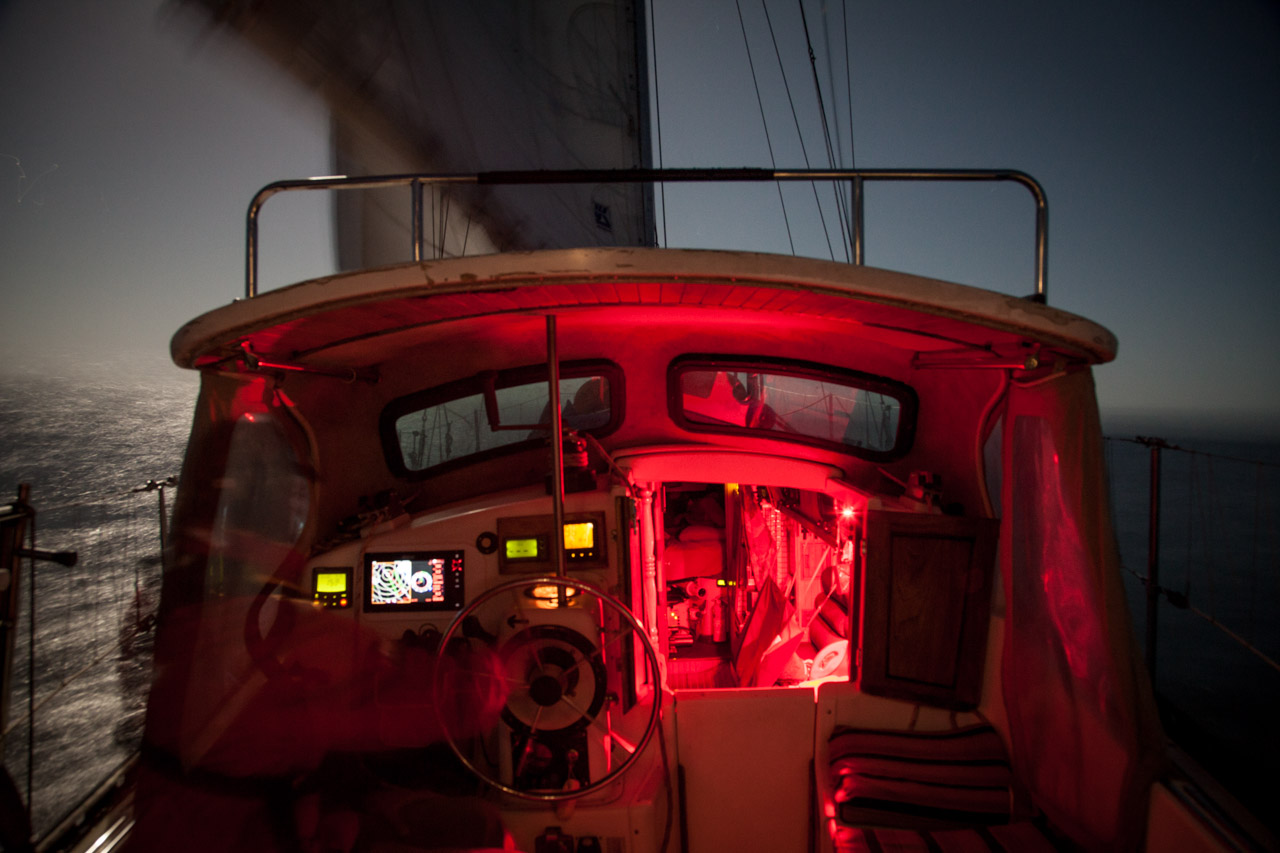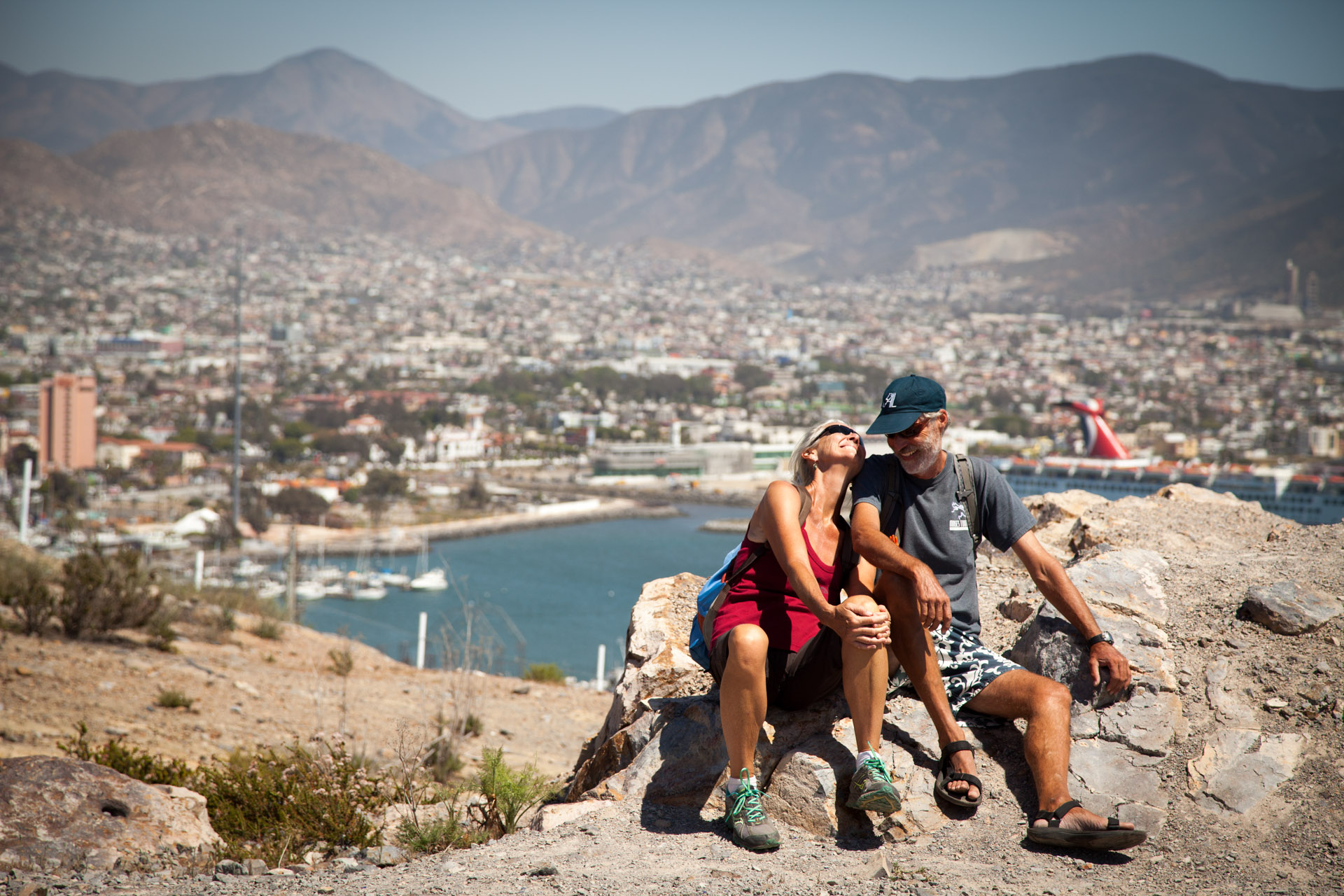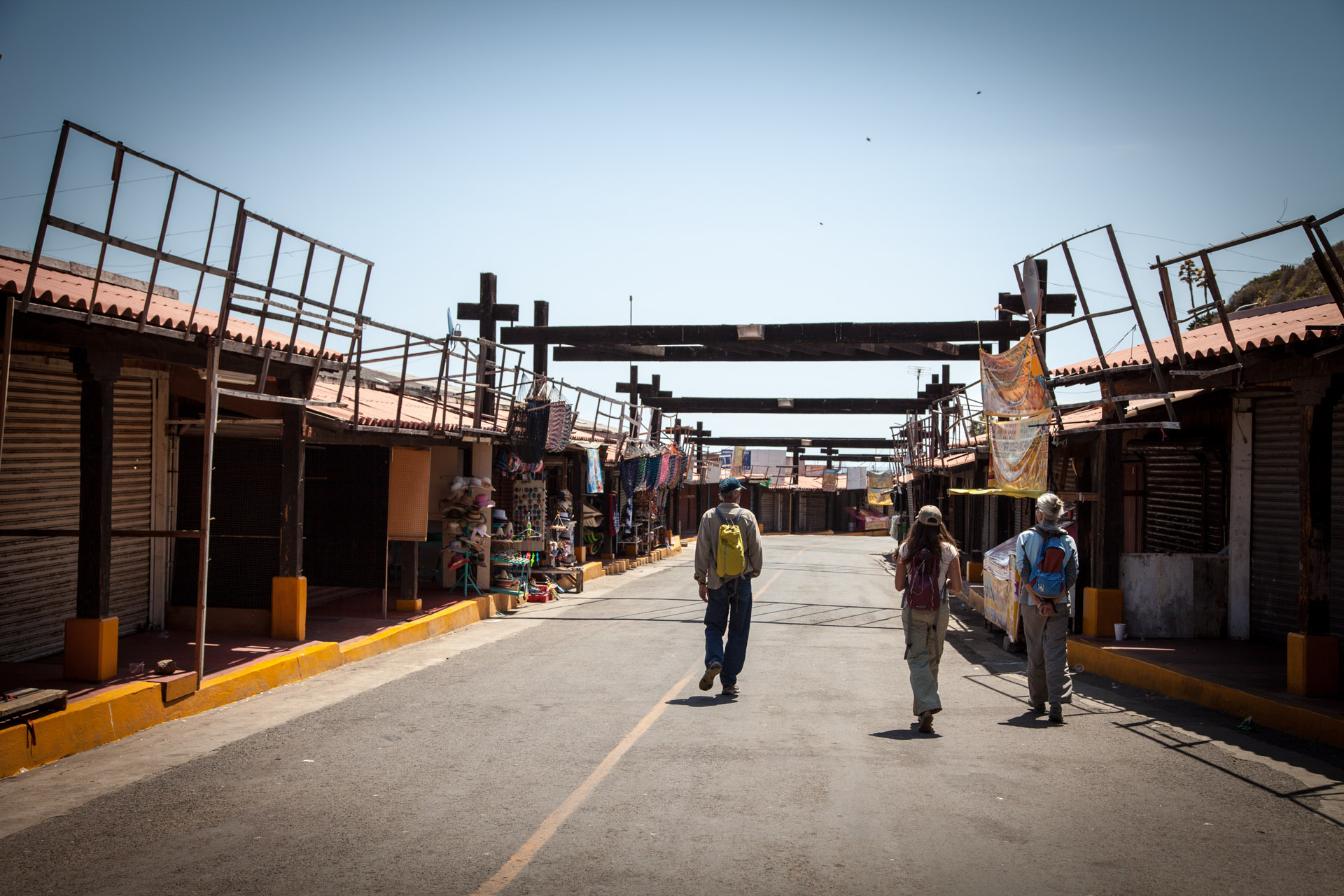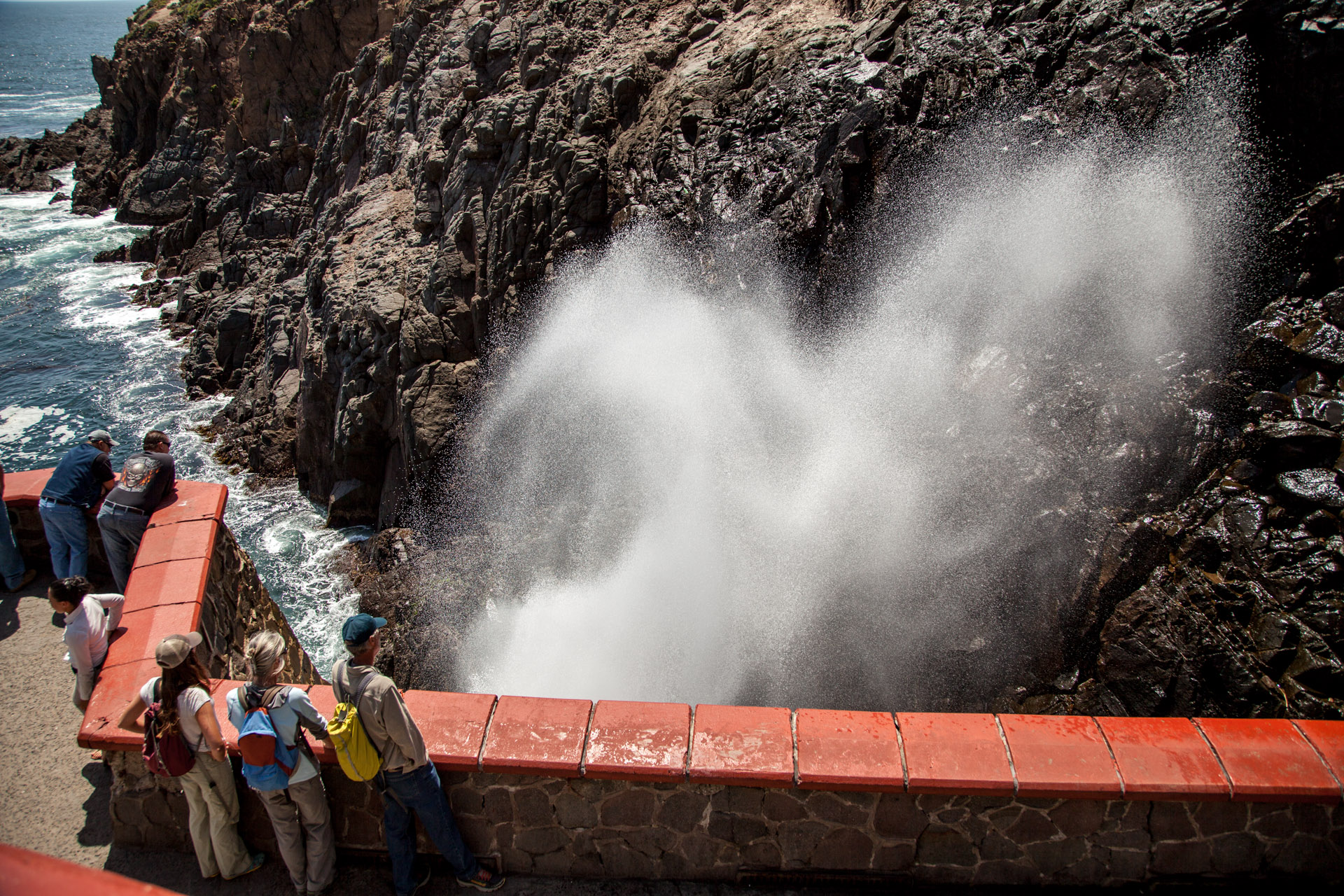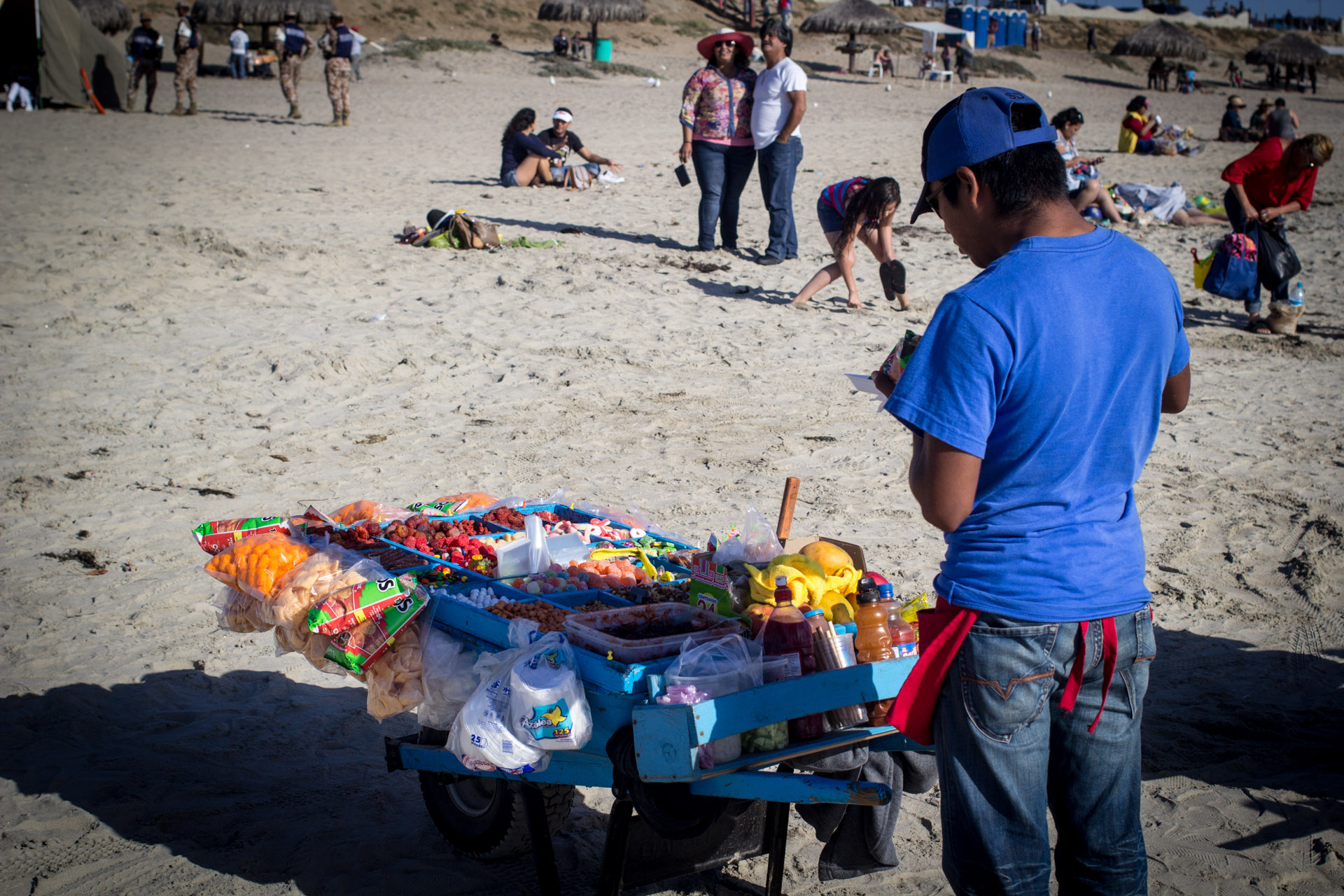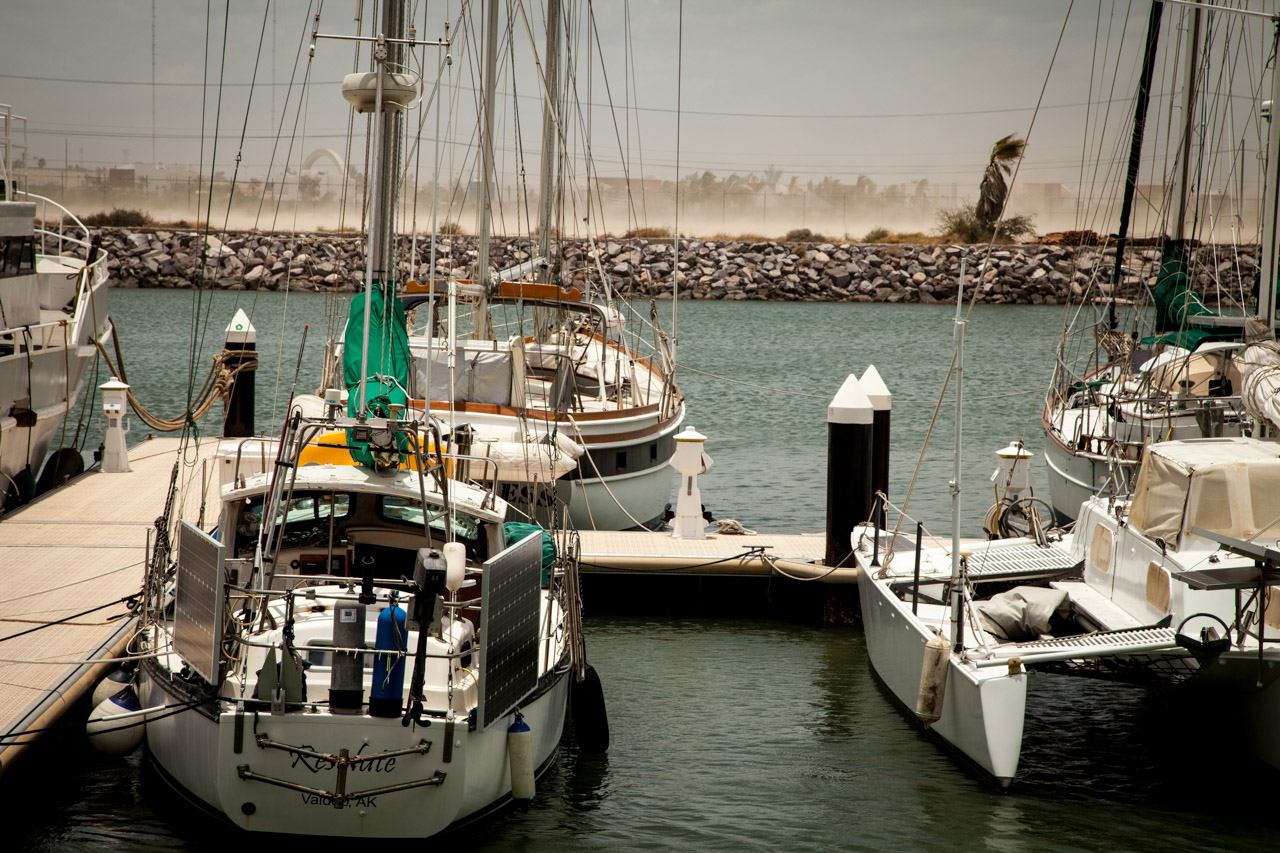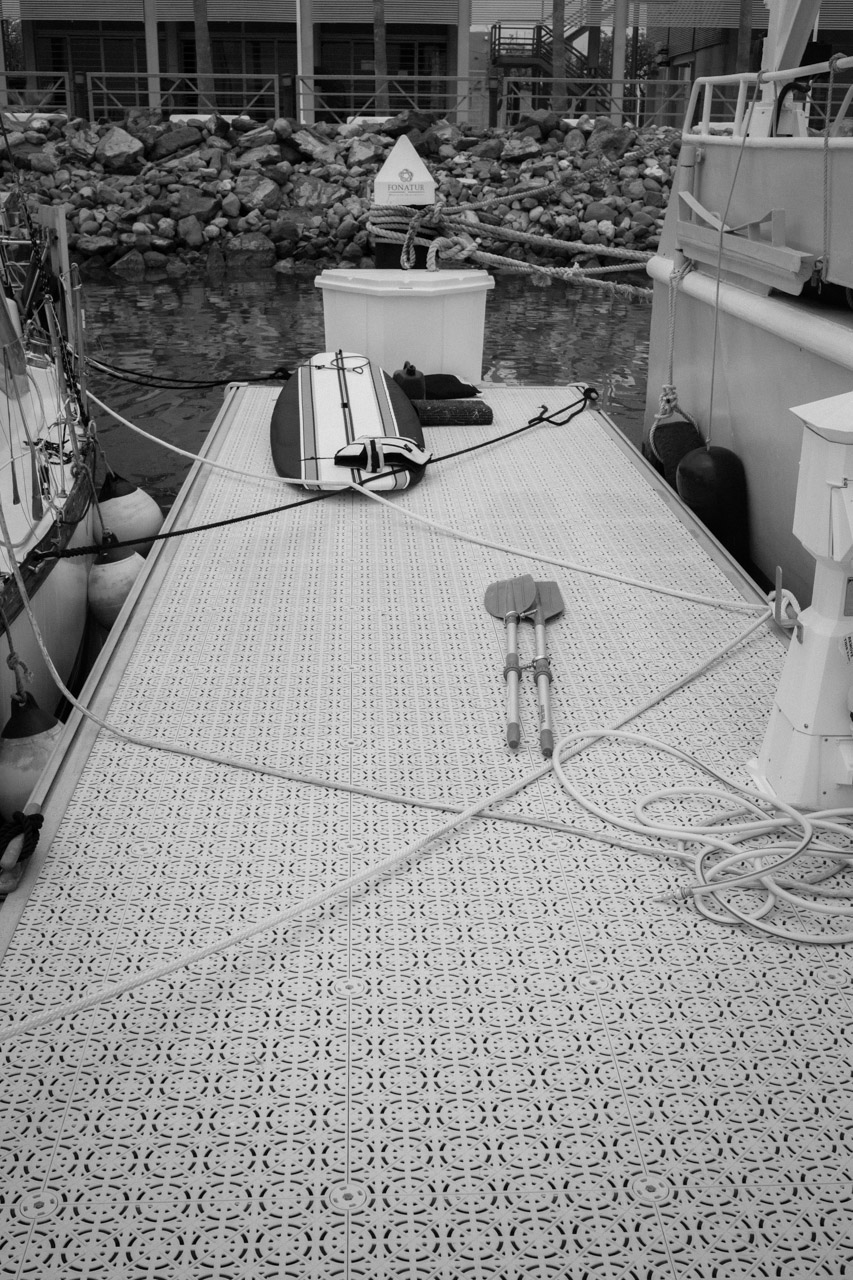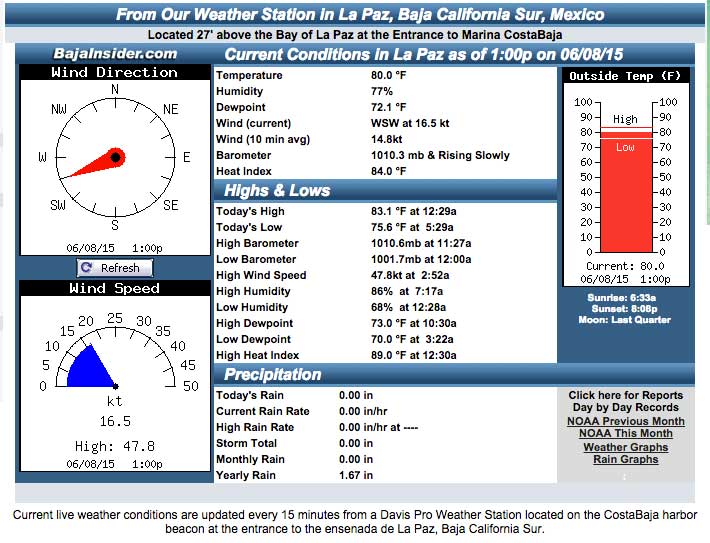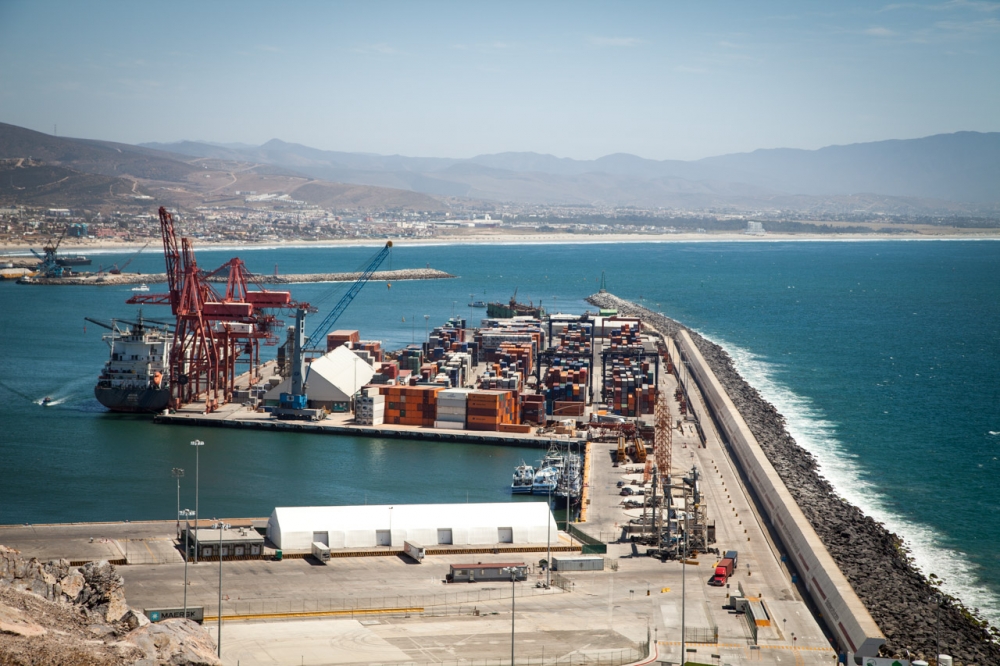We are nearly always dragging a lure behind Resolute. And why not, plucking your dinner straight from the sea just before dropping the hook in some secluded anchorage, who hasn’t dreamt of that at some time or other? We are not huge fisherman, our fishing tackle mostly consists of a few hundred feet of 100 lb test line, some different colored squids and the Cuban yoyo hand line. Despite this, we have been very successful in catching fish on practically all our passages. I think the secret is our pink squid!
We have a couple of catches that stand out from the other more normal tuna, black skipjack, dorado, etc. Our first was while leaving La Paz, we were around 3 miles outside of the entrance channel on a gently sloping sand shelf in around 40 feet of water when Meagan yelled “Fish On!!!” to me down below looking at our charts for the day. We did our usual, reduce sail to spill speed, drag the fish for a little while to tire it out and then begin hauling in on the hand line little by little. After what seemed like quite awhile, as this fish was fighting harder and a little different from others we caught previously, we saw our first glimpse of the tell tale shark fin. Hmm, “this might get interesting” we said to each other at the same time. Once getting the little shark alongside the boat we got a great view of this guy’s infamous shark teeth as he angrily snapped and thrashed trying to bite that pesky lure just inches in front of his cat like yellow eye.
After a little powwow and looking at how the lure was stuck in his jaw we decided the best course of action would be to slide a sharp knife right down the hook and slice open the flesh on his lips as he had not actually hooked any “bone”. This would hopefully leave us with our lure and him without a large hook or line trailing from his jaw for several days. If not making it harder for him to catch more food it would at least make him less attractive to the females I imagine, and I would hate to be the cause of that. The plan worked flawlessly and our little companion wasted no time sending a jet of water right into our faces as he muscled his way down to deeper and safer water.
The second time we were outmatched was when crossing from Guaymas on the mainland side of Mexico to Bahia de los Angeles on the Northern Baja Peninsula. We had around 60 feet of line out and were passing through the salsipuedes channel , a narrow channel renowned for its fast currents and funneling winds. Once again the call was made for “all hands to battle stations, fish on!”. I began pulling in and wham, “whoa, now this is a big fish or we just hooked the bottom” I said to Meagan, blue faced and straining to not loose my tenuous, sweaty grip on our severally outgunned hand line. I think at one point Resolute may have gone backwards, we will have to consult the GPS track for confirmation. A little more fruitless panting and heaving on the line and we had gotten the behemoth to with, oh wait, we had given him another 40 feet putting our total line out to around 100 feet. It was at this point we we graced by one of the most amazing sights you can see, a beautiful sail rising out of the water and slicing the waves in front. We had caught a Marlin!! With a little more renewed vigor we managed to pull this 5-6 foot thrashing fish to within 50 feet of the transom when I nearly fell backwards and over the lifelines. “What was that?” I coughed as I began cautiously pulling in on the line again. We though the fish must have spontaneously died as there was clearly something on the line still but there was no fight left in him. The answer was soon revealed as we pulled the near zombie like remains of a Jack onto the side decks. The only explanation being that we had caught our Jack friend moments before he had been swallowed down and partially digested by our much larger Marlin friend. Fortunately for us, we were saved the head scratching of trying to figure out just how to get a 100 lb angry Marlin onto our boat without one of us being lanced through the stomach.
Any help identifying the shark species would be greatly appreciated by the way, my best guess was a small lemon, by I am the last person I would ask about such matters.
Tag Archives: Mexico
Life in La Paz, Mexico
Life in La Paz is easy, days full of swimming with whale sharks and eating street tacos, nights filled with eating street tacos and good beer, and finally ending with melodic music drifting down to your bed through the open hatch boards. After the open roadstead anchorages of Western Baja and the wild and crazy lifestyle of Cabo San Lucas, La Paz is a welcome change of pace and a fantastic place to get settled into life in Baja for the cruising sailor.
We spent almost three weeks exploring the sights of La Paz. And to think when we arrived we told people we would be gone in one. In cruising, changing plans is a way of life, plans are formed and reformed as fluidly and as often as the waves strike our hulls. We met some of our closest cruising friends in La Paz. Some of whom we would spend the majority of our summer in the Sea of Cortez anchored next to in the same harbors.
Cabo San Lucas to La Paz: A Photo Essay
Since we’ve been a little preoccupied with the hurdle of creating our first sailing vlog (video log) episode 1 Resolute Sets Sail, the blog has been a touch neglected. So please if you haven’t already watched our first episode check it out and if you like what you see Subscribe (there is a link at the end of the video or you can select the red button beneath the video if you’re watching in YouTube).
…
We sailed from Cabo San Lucas to La Paz stopping in Los Frailes for some incredible sunsets and balmy hikes with expansive views. We used our pole spear for the first time and were rewarded with several nights of tasty reef fish appetizers. Continuing north we bashed into 20 knot winds with the aid of the Sea of Cortez special, steep, short period waves. Add to the conditions a strong current counter to the winds and it made for a rough and tedious day. Poor planning, but chalk it up to another little adventure!
As for the rest, I will still my ceaseless ramblings for a change and let the photos do the talking…
Erik… you’re up:
Welcome to Cabo!
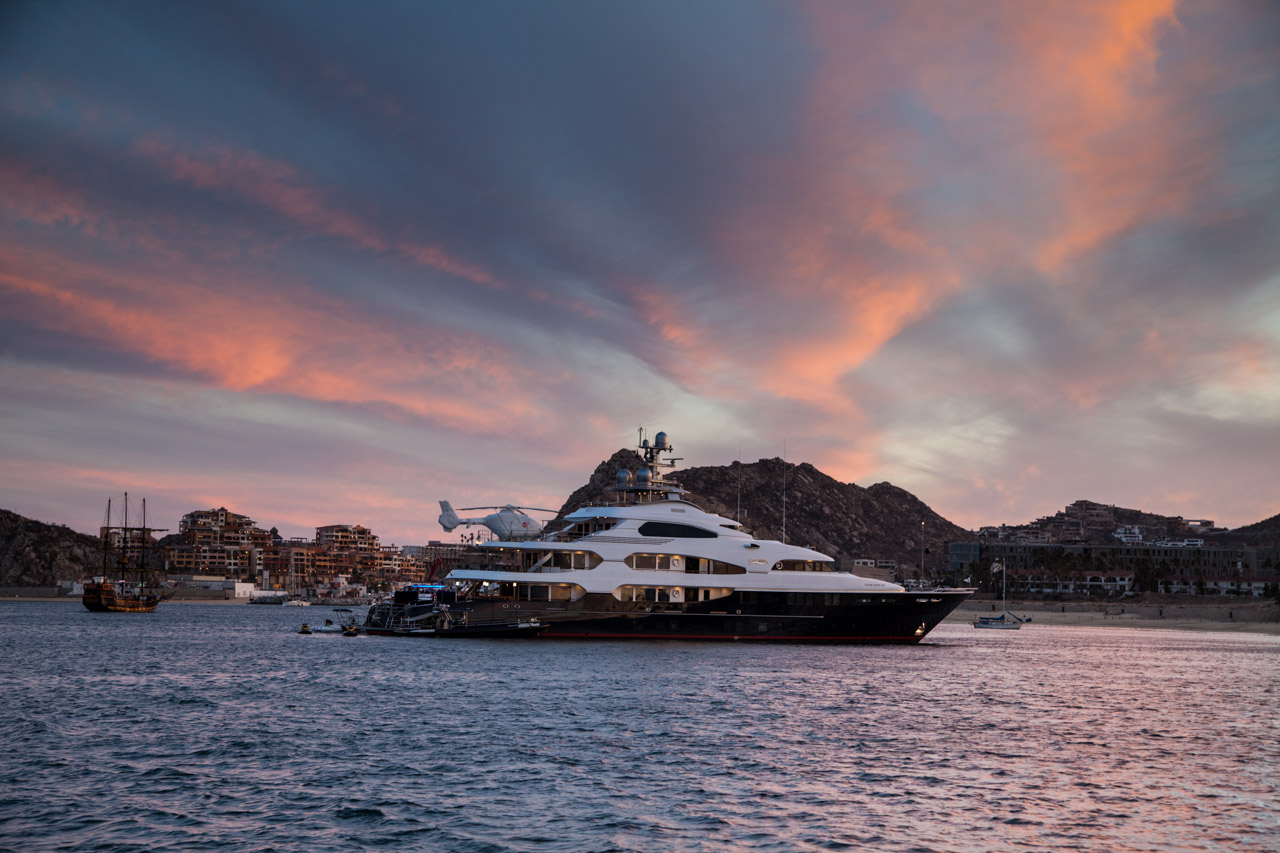
Megayacht in front of Cabo skyline, our friends Westsail 32 “Lacuna” anchored to the right of megayacht (for scale)
“SHE IS A LARGE DOG.” Her sunburned arm stretched in the direction of Nikka, sitting patiently by my side. I studied the woman quizzically, not understanding how this was a revelation or something that needed to be pointed out to the person who was holding the large dog’s leash. She glanced over at her friend who gave a shrug, and started again. Louder this time.
“SHE IS A L-AAAAA-RRRRR-GE DOG. L-AAAAA-RRRRR-GE.”
As she uttered the second l-aaaaa-rrrrr-ge, her friend thrust her arms wide, before jabbing her finger in Nikka’s direction. At this strange display of behavior, I nodded my head and began to slowly shuffle backwards, securing Nikka safely behind me as I went. Still exhausted from our arrival in Cabo San Lucas less than 20 hours earlier, I had little patience for crazy, and even less patience for tourists fully embracing their inner Cabo Wabo. As I turned to go, the women waved me back asking in their booming, excruciatingly slow diction,
“ARRRE YOOOU FROOOM HEEERRRE?”
And it finally hit me. These nutty women thought I was a local (apparently one of the few who did not speak passable English), and had subscribed to the same seemingly ingrained theory that too many Americans resort to time and again:
Draw them out long enough, raise the volume high enough, and anyone will understand the words coming out of your mouth.
Meanwhile to the rest of the world, we (Americans) come across as crazy… and perhaps slightly intoxicated!
An hour before my encounter with the Large Dog tourists, Erik and I sat down to enjoy an ice cold beer at one of Cabo’s many waterfront restaurants. We were starving, but the menu’s exorbitant prices, presented in both US dollars and Mexican pesos (a sure sign you are getting ripped off) persuaded us to settle for a liquid lunch. We were waiting for our friends Karina and James to arrive from the San Francisco Bay Area.
A journey which for us had consumed over three months by boat, they squandered less than a day by plane, arriving in Cabo a mere 5.5 hours after lifting off from SFO!
Assuming the average mid-sized commercial jet uses approximately 7,000 pounds of jet fuel per hour, with 4 hours of actual flight time and approximately 200 passengers per plane, that very roughly equates to 20 gallons of fuel per person. In comparison, our jaunt down the coast took 400 times longer and used 15 more gallons of fuel per capita, not exactly the most efficient way to travel. Ugggh, why do we feel the need to calculate these things!
While we sat nursing our Pacificos, Jorge, a young man in his mid 20’s who was responsible for corralling tourists off of the streets and into one of the restaurant’s high backed wood chairs (not bad at his job, a testament to the fact that we were currently plopped down in two of those chairs), regaled us with his knowledge of all 50 U.S. State Capitals. After slinging through 20 of our more obscure states, it was obvious he knew his stuff. When he saw we were impressed he decided to up the ante, moving onto official state nicknames and putting us to shame. While he was flying through nicknames at a staggering 90% success rate, I was lucky to come up with 8, and over 50% of those states I have called home at one time or another.
Turns out Jorge had lived in Georgia for several years before being forced to leave the U.S. and move back to Mexico. He did not appear to let the experience sour his love for our country, however, you could hear it in his voice, in the way he described the lush Georgia countryside and his unquenchable thirst for U.S. facts and trivia. Erik and I were in awe that a man could harbor so much love for a country that had closed its doors to him. As I took my last sip of beer, I felt the hunger in my gut solidify into a tight, uncomfortable ball of guilt, realizing that what this man loved enough to learn about and memorize facts, for me had merely been a birthright.
On our dinghy ride back to Resolute with our two good friends by our side, I looked to the vast blue ocean splayed out in front of us and my lips curled into a smile as I thought, the Ocean State, hey that’s Rhode Island. Nothing like traveling 1,000’s of miles from home, to learn something new about it.
Musing on Mexican VHF
The VHF radio is a very different beast in Mexico.
Less than 100 miles south of the border, the coast guard and distress calls that clutter channel 16 in San Diego are all but absent. Replaced by seemingly random conversation and very sudden, booming hails. We were forced to lower the volume when the jolting hails began to send Nikka shaking and flying from her bed. Her least favorite type of hail, a very sudden, piercing whistle repeated three times in quick succession before a quick pause and two final whistles. Upon first hearing such an ear piercing nondescript hail, we assumed that similar to the U.S, the person was likely intoxicated and enjoyed the idea of their voice going out to a wide and compulsory audience. Not so in Mexico it turns out. The legitimacy of the hail was confirmed for us when we heard a man, whom we could only assume was not able to whistle, repeat the words,
“whistle, whistle, whistle” pause “whistle, whistle!”
My favorite Mexican VHF moment so far this trip was when Erik and I, surprisingly bored of each other’s company by day 2 of a 5 day sail, contemplated finding some music to play in the cockpit. Erik quickly waved the idea away, saying, “sounds great, but we don’t have any music.” Just as the sic in music left his lips the VHF sprang to life with the sounds of a mariachi band in full swing. Until the music broke off about 2 minutes later, Erik and I just stared at each other in disbelief. Then after checking to make sure our mic wasn’t keyed, laughed until tears welled up in our eyes. We tempted fate again with “we don’t have any ice cream,” hoping that if an ice cream sandwich did not drop from the sky at least a Dryer’s commercial might play from our speakers.
But nothing, so we settled back into the cockpit, still a little weary about who may be listening.
As a side note: VHF in Mexico utilizes the USA channel list, as opposed to the international channel list, which we had assumed when we first arrived. The different channel lists are similar enough to make you think you have it right, but different enough to drive you crazy. For example, due to restricted frequencies in the US, Channel 22 receives on a different frequency than the International setting, making it very difficult to hear morning nets and communicate with other cruisers who exclusively use Ch. 22.
Putting on the miles
THE FIGURATIVE WINDOW which held our weather forecast stood wide open, but nonetheless I was anxious. Prior to last week, I frolicked in the blissful ignorance of never having felt the contents of my stomach instantaneously liquefy while every inch of my skin erupted in icy beads of sweat. Never felt the boat launch wild figure 8’s beneath me until direction became relative and a vigilant eye to the horizon was the only thing reaffirming my faith in gravity.
Up until last week, I had not experienced sickness at sea.
Fortunately for me (and perhaps more fortunate for Erik) not a hint of sea sickness threatened to thwart our beautiful 300 mile sail south from Bahia de Tortuga to Magdalena. We were the picture of health, although I have to admit our stomachs did mildly protest at the immense volume of pork stew we were forced to consume over our 5 days at sea. Dreading another round of sea sickness and learning first hand how much food is prepared and consumed when one member of the crew is on watch for 36 hours and the other one is drooling into the stitching of the settee cushions, I decided to prepare our meals in advance. Unfortunately, I made the mistake of assuming, similar to our last sail, we would be ecstatic with anything edible as long as the minimal effort required to consume it amounted to ripping off the lid of a tupperware container and digging a utensil out of a drawer. I was wrong. On day 4, Erik fished the last rubbermaid out of the fridge, still brimming with a chilled concoction of limp vegetables and sinewy meat, and spooned it into a large stainless steel bowl at the bottom of our companionway steps. At least Nikka appreciated my meticulous over preparation.
On the morning of our 5th day at sea, the brown rocky headlands of Bahia Magdalena materialized out of the limited range of blue hues we had grown accustomed to over the past week. We were at once struck by the bay’s uncanny resemblance to a body of water we departed one sunny afternoon, over 3 months and 1,000 miles earlier. It felt as if we had been hurled back in time, catapulted by the Tardis, to a San Francisco Bay similar to the one the Spanish first encountered over 240 years ago. A time before resplendent, awe-inspiring bridges and clanging trolley cars, a time when the riches of the Sierra Nevada still lay concealed under the meandering water of rivers and thin mantles of vegetation. Catching a ride on the powerful tidal currents, we serendipitously arrived during flood tide, speeding through the entrance and finding ourselves on the outskirts of a vast, shallow bay. The strong northwesterlies followed us inside while the pesky ocean swell vanished, reminding us how lucky we were to have a large protected bay like San Francisco as a playground for an entire year.
We were flying through the water, it was good to be back.
After spending 24 hours in Magdalena, 20 of those hours spent horizontal, we were refreshed and eager to sail the final 140 miles to Cabo San Lucas, where we were hoping to replenish our stock of fruits and vegetables that had run out days earlier. On the way south we found ourselves battling that common cruiser’s adversary, time. In 48 hours our friends were landing in San Jose del Cabo, and we were cutting it close. Two days may have been no problem for Resolute close hauled or reaching, but Cabo lie directly downwind, and even with the wind blowing a steady 15 knots, we were moving slooooow. Not to mention the motion of Resolute on a monotonous downwind run in choppy seas is like a screen door flapping wildly in the wind, swinging squeakily on its hinges and crashing to a tumultuous halt at the limit of its springs before starting back again in the opposite direction. What we lacked in comfort was more than made up for in beauty, and instead of spending my night watches like I usually did, nestled into a book combating sleep with the aid of my watch alarm, I hung from Resolute’s stern arch awake and in awe of natures spectacle.
The moon shone round as a lollipop as it dripped a shimmering trail for us through the dark turbulent water, creating a scene more reminiscent of driving down a rutted Alaskan backroad than sailing the open ocean. The clouds were tiny puffs, flowing white in all directions until finally melting into the sea in the distance. The stars momentarily peeked out from behind the clouds, rewarding the patient observer with a quick glimpse before dissolving into the background. As I hung there with my mouth ajar, I was filled with an overwhelming appreciation for soggy foul weather gear, safety harnesses, and crushing exhaustion. I knew if I had not been on watch in the middle of the night more than 20 miles from the nearest land, I would have been sound asleep on some cozy pillow top mattress oblivious to the simple fact that a full moon hung heavy in the sky.
Rough stomach on an unsettled sea
Excitement swirled with apprehension in the rigging above our heads, our emotions palpable, like dense fog on a windless San Francisco morning. As we motored out beyond the sanctuary of Ensenada’s protective sea wall, the tranquil waters of the harbor were abruptly replaced by jarring short period swell and erratic, splashy wind chop. By the time we had coerced the sails into place, the slightest hint of a grumbling began down in the deepest reaches of my belly bringing with it the nagging sensation that started approximately 1 hour earlier, as the last bite of fried fish taco passed my lips. The rough seas and greasy street food paired well with the intense pain that had been radiating outward from my eye sockets for the past two days, the result of a tenacious sinus blockage. Exhausted and overburdened with emotion and sickness I wearily succumbed to my first bout of sea sickness approximately 10 minutes into the 4 day, 360 mile sail from Ensenada to Bahia de Tortuga. While Erik propelled us into the restless sea, I curled into a tight ball in the back of the cockpit, my arms like jib sheets wrapped tightly around our port side winch, clinging and hugging it to me while my head rested lazily on top. I huddled there for hours, unfolding myself intermittently to crawl clumsily over the cockpit comings and while desperately clasping Resolute’s beefy toe rail return the contents of the taco to the sea. At some point during my delirium, Erik disappeared down the companionway, returning several minutes later with a plastic Ikea cup brimming with a fizzy white substance. He shoved the cup in front of my nose and suggested rather authoritatively that I consume its mystery contents. I hesitated for a moment, realizing that my pitiful groaning and melodramatic mutterings of “kill me now” may have been enough to lead any man to murderous tendencies, especially one trapped on a 36 foot piece of real estate with access to a profusion of toxic boat chemicals. I sniffed at the milky liquid, trying to weed out the presence of any exotic contaminants. Finding the smell mildly pleasing and for once not in any position to argue with him, I weakly dislodged the cup from his grasp and poured the chalky liquid down my throat. Within minutes, I lay sprawled and snoring in the crisp folds of our new lee cloth. Drugged and happy with, Erik informed me later, two nighttime Alka-Seltzer tablets coursing through my system.
A day and a half later (I know, I know, I am very sensitive to antihistamines) I peeled myself away from the settee and stumbled out into the moonless night, just in time to watch Resolute surf down a massive wave at a hull speed crushing 10.2 knots. Green water spat and foamed from threatening heights as the waves fitfully alternated between hurling us forward on their crests and stalling us in their troughs. I turned toward Erik, huddling from the Beaufort force 7 winds under Resolute’s sturdy hard dodger, his eyes bloodshot and swollen, no doubt exhausted from his 36 hour watch. Less frightened than I should have been since my head was still a cumulonimbus of drug induced euphoria, I nonchalantly inquired, “do you think we might want to reduce some sail?” He abruptly snapped out of his own delirium and we hove to for the rest of the night, permitting Erik to catch up on some much needed shut eye, and myself ample time to awaken from it.
The monstrous waves and howling winds accompanied us for our remaining two days at sea, and when we finally limped into Bahia de Tortuga we were completely and utterly exhausted. However, five minutes into our visit to the sunny, placid bay we had half of a gorgeous (25 lb) Yellowtail filleted and delivered to our boat for the minimal cost of 50 pesos (an equivalent to 3.5 US dollars) and two cold beers. We smiled and lit the barbecue, already forgetting about the tribulations of the last four days and excitedly planning our next jump down the coast.
La Bufadora
On the way home from their own cruising adventures in the Caribbean, Erik’s parents made a pit stop in San Diego and bused themselves down to Ensenada for a quick visit. Unfortunately the anchorage prominently displayed in two of our three outdated guidebooks was no longer accessible, as it happened to currently lie in the heart of Ensenada port traffic. A diverse assortment of vessels transited the proposed anchorage, including speedy sightseeing boats with only the tiny heads and flashing cameras of tourists visible above a sea of bright orange life preservers, and slower, but significantly more intimidating cruise ships whom mysteriously appeared in twos (the ultimate form of buddy boating) and never stayed long enough to facilitate growth on their underbellies. Finding the anchorage non-existent and feeling less than inclined to take part in another bout of extreme anchoring at Islas Todos Santos, we decided to once again make Baja Naval Marina our home away from home. This time basking in the easy living they supplied (internet, showers, and phone, oh my!) for well over a week, a long time for two people who thought San Diego would be the “last time” they saw a dock.
Our first day back in Ensenada we set to work checking off the single task from our lengthy to do list that demanded immediate attention. No, it was not our finicky fuel system that starved the engine of diesel a mere 30 minutes into our trip, leaving us bewildered and bobbing in the Alameda Estuary, and has continued to plague us at every rocky, narrow, shoaling, topographically inopportune moment ever since. Nor was it the bracket on the pulpit which sheared in heavy seas outside of Monterey, causing (prior to Erik’s mad rope skills) our starboard lifeline to flail wildly. No, the task that vaulted itself out over the page, skidding to a stop at the base of our twisted tongues every time we tried to communicate with anyone other than a fellow cruiser, was our desperate need for some Spanish instruction.
We found Señora Aguipa through her flyer which she astutely stapled to the bulletin board of the marina lounge, displaying directions to her office in bold black letters, and given in relation to, like all of the directions we received in Ensenada, the McDonalds. Her modest office was tucked, “six doors south from McDonald’s” along a tidy street lined with sidewalks of bright orange brick and peddlers selling colorful trinkets and pharmaceuticals. The clean, continuous sidewalks and endless supply of stuff to buy at exorbitant prices was an immediate indication that her office was smack dab in the heart of tourism, however, her prices were astoundingly affordable, working out to approximately $2.50 per hour in U.S. dollars. On the morning of my first lesson, I found Señora Aquipa hunched over her desk, a slender woman with dark curly hair and kind eyes hidden behind a pair of chubby glasses. Her torso wrapped in a cozy knit sweater, as if she was somehow insulating herself against the sweltering Ensenada heat, the same heat simultaneously consuming Erik and I in our shorts and t-shirts. Through her exceptional and quirky instruction I was quickly becoming confident in the most basic and useful of situations, “I am…”, “I want…”, “I need…”. On my 5th session, she surprised me with the popular phrase, “no me odies por ser bonita,” or in English, “do not hate me for being pretty.” She never explained why she was teaching it to me, but there it was written down in the notes she had prepared that day, right below ser and estar conjugations. As she told me the phrase her face cracked into an infectious smile while a small uninhibited giggle escaped her lips. She averted her eyes down to the notebook in front of her whispering in a barely audible escape of breath, “you never know, you might need it one day.” In the 7 days I spent under her adept tutelage I learned far more than just vocabulary and verb conjugations. She educated me in the intricacies and curiosities of Mexican culture and history, and through her gentle feminism in the heart of a machismo culture, she inspired in me a unique confidence in my own femininity and ability to one day let Spanish glide effortlessly off my tongue.
Emboldened with our shiny new Spanish skills, we searched our overcrowded to do list for the next unsuspecting item to boldly strike-through. First, we decided to tackle the pesky pulpit bracket, and within 12 hours of describing our dilemma to Jugo, the yard manager at Baja Naval, the bracket was fully restored, complete with beautifully executed welds (which the welder precariously tackled with a portable welder from our unsteady bow) and affordable price tag. Strike that one off the list. Then, Erik put his father to work helping him troubleshoot our continued engine woes, and although they were not able to fix anything, they did discover, much to our dismay, that our toddler of an engine (less than 5 years old) was installed improperly and would take a lot more than an afternoon in a cramped engine compartment to get it straightened out. I suppose it’s better to know, add engine bed rebuild, new engine mounts and alignment to the list.
While Erik’s parents were in town we decided to take a break from the boat life and venture inland by bus for the day. Braving Ensenada’s confusing bus system with their erratic scheduling and abundance of seemingly similar bus stations was made infinitely easier by his parent’s fluent Spanish, and so we scooted along the two bus, 45 minute route south to La Bufadora with relative ease. Upon arrival, we were instantly hustled down a long gang plank of homogenous tourist shops culminating in the anticlimactic blow hole coined La Bufadora. As with most things in life, however, it’s all about the journey, and our little adventure inland awarded us sweeping views of active farm lands rising up into verdant hills before dropping again into a jagged cluster of sea and rock, delectable late afternoon snacks of Ensenada’s finest seafood washed down with cold cerveza and horchata, and along the walk home from the bus station, a chance encounter with a quaint bakery whom we helped to offload a significant quantity of pan dulce.
Minutes before sailing back out into the open ocean we took Nikka for a brisk last minute walk through the food scrap lined sidewalks of her favorite nearby park and were delighted to stumble upon a taco vendor digging greasy strips of fish from a vat of frying oil. We decided from the heft of the coins jiggling in our pockets we had more than enough pesos for a couple tasty tacos and hastily sprinted over to the stand to order four tacos “con todo” or “with everything.” I look back at this moment with a feeling I would not exactly describe as regret, but more a simple curiosity of how it was possible that Erik and I could have thought eating greasy street tacos mere minutes before heading out on a multi-day sail in the merciless Pacific was a terrific idea. (Spoiler alert for our next bog) It wasn’t…
Hurricane Blanca
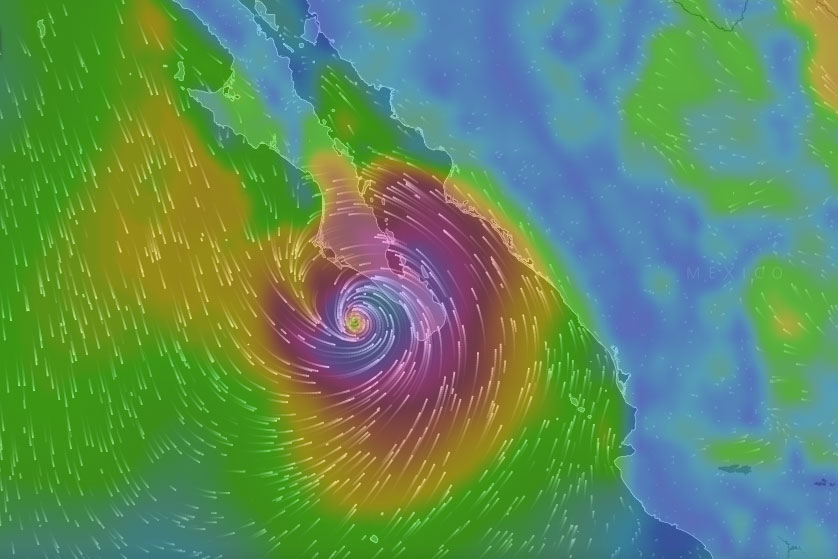
windyty.com screen grab of hurricane blanca 6/8/15 12 A.M.
Hurricane Blanca, aptly named for the light colored dust she spewed on every available surface of our boat, was a tropical storm by the time she passed above our slip in La Paz. Her highest wind speed was clocked at 47.8 kts at 2:52 am at the Costa Baja weather station near the entrance to La Paz. Luckily with the lighter than predicted winds, every boat that weathered the storm with us at Marina Fonatur was completely free of damage. The only injuries I am aware of was my own small puncture wound, the result of stepping on a tack while shielding my eyes from the incessant onslaught of driving dust, and several cases of complete and utter boredom. Instead of seeing the days of diligent preparation as a waste, we are chocking them up to excellent practice for the storms to come. Most importantly, having learned that it takes approximately twice as long as we thought to prepare the boat for a storm and about three times as long if the temperatures are above 95 degrees F.
The highlight of the days leading up to the storm came in the form of an impromptu pot luck bbq, where several of us weary storm preppers gathered around the marina pool munching on a random assortment of delicious finger food and allowing ourselves to forget for a fleeting moment about a storm named Blanca. The strong sense of community ever-present in the cruising lifestyle is amplified during difficult times, and Blanca was no exception.
Crossing the Border
We woke at 1:30 am still nestled in our slip at the transient docks in San Diego. One snooze alarm later we dragged ourselves out of the v-berth and brewed some coffee, undressed the sails, took Nikka for a stroll, and lashed the few things on deck not already bolted down. An hour later just as we decided we were as ready as we were going to get, Erik started in on a lot of last times talk. “Say goodbye to the U.S. may be the last time. May be the last time at a dock…” I’m pretty sure he meant the last time for awhile, but he left off that end part and the stress of his last time business mixed with my heavy apprehension over the border crossing ahead created an unsettling concoction in my gut. I about lost my nerve when Erik marched Nikka and I over to the wide grassy area near the docks to touch U.S. soil, for you guessed it, “the last time.” For a change of pace and practice we switched up the routine and I reversed us out of the slip while Erik shoved us off. We were out of the channel and back in the Pacific before I handed the reigns over and shrugged off the tension of the morning, losing myself in the dark nutty aroma of my coffee, which up until that moment lay untouched in its thermos.
Several miles before we crossed, the border ominously peered through the darkness to the east. Even at night we could clearly make out the large lighted fence with vast no man’s land dividing the sprawling city lights of the north from the south. Crossing the border by boat was surreal. Less than 5 nautical miles off the coast we nonchalantly motored past under the cover of darkness, with no passport checks or customs forms to fill out. I couldn’t help shake the feeling we were crossing illegally, and as the sun peaked above the arid Baja hills I caught myself scanning the horizon, half expecting to see the Mexican border patrol speeding after us.
As we neared our point of entry, I hastily grabbed a copy of Charlie’s Charts and decided to do a last minute review of immigration requirements. While skimming the opening paragraphs I came across the typical hours for Mexican businesses which are apparently 9-3 Monday through Friday. Our anticipated arrival was 3 pm, and did I mention it was Friday? Shit! My tongue hung heavy at the base of my throat making it difficult to swallow as large beads of sweat began multiplying on my forehead. The clock was ticking, Nikka’s health certificate was signed almost 18 hours prior and we had to be in the immigration office, certificate in hand before the end of 72 hours.
Through the commotion of finalizing boat projects, buying last minute provisions, and checking off requirements to allow Nikka entrance into Mexico and later Hawaii, I had completely neglected such a minuscule thing as business hours. I tried to hide my immense oversight from Erik, but by this time the sweat had started dripping down my cheek and pooling at my collar bone. He took one look at me and knew the news was not good.
We soared the rpm’s, finally gliding into our slip at Baja Naval around 2:30 pm. With potentially half an hour left until close of business I hastily lofted our starboard bow line to Carlos, the Baja Naval employee who met us on the dock, and attempted to explain our need for haste through an embarrassing barrage of rusty spanglish. He looked at me for a moment then smiled as he informed us in excellent English that the offices had closed early that day and we were mere minutes too late. Seeing the harrowed look on our faces, he quickly continued to explain that lucky for us, the offices are open one Saturday a month and we happen to be there the day before just such a Saturday!
By the time we finished checking in with the marina and took Nikka for a short walk we were exhausted and ready for a well deserved night’s rest, but unfortunately the good luck we had earlier dissolved with the setting sun. At 11:30 we were startled awake by the jarring whine of the propane sensor alarm. Annoyed and exhausted, Erik closed the propane tanks and reset the sensor. Although we were not about to go lighting matches, we did feel safe enough to eventually drift back to sleep. Not more than an hour later we woke again, this time to the screeching of the CO detector, “beep, beep, beep, CARBON MONOXIDE, CARBON MONOXIDE” it repeated over and over again as we groggily grabbed Nikka and fumbled through the companionway into the fresh, salty air of our cockpit. Realizing that our heavy eyelids and throbbing heads were the result of mild CO poisoning we stayed topsides and waited for the boat to sufficiently air out enough to silence the alarm. Both of these alarms sounding off in similar succession was eerily reminiscent of a night we spent in Half Moon Bay at the very beginning of our trip. In both instances our boat was filled with exhaust from a neighboring boat either idling their engine or running a generator, causing a false alarm on the propane/gas monitor and a very real, very accurate, and very scary alarm to go off on our CO monitor.
The morning after our night of alarms we woke early and arrived at the immigration office as they were opening their doors. The check in process was surprisingly painless and although we ran back and forth between offices like a pinball, we were done with the entire process before noon. It turns out the customs official was not even interested in the fact that we had a dog with us. When I thrust Nikka’s health certificate at him, imploring that he at least glance it over, he just smiled a toothy grin and shook his head from side to side as he motioned for me to remove the paperwork from his desk.

